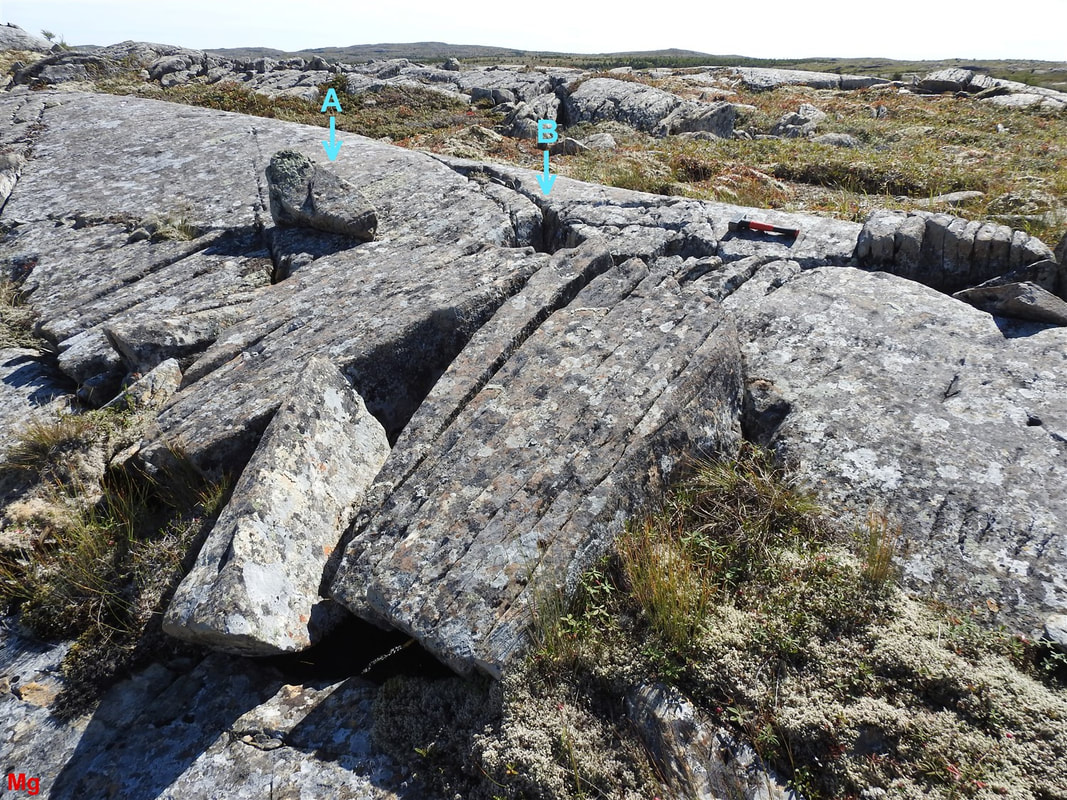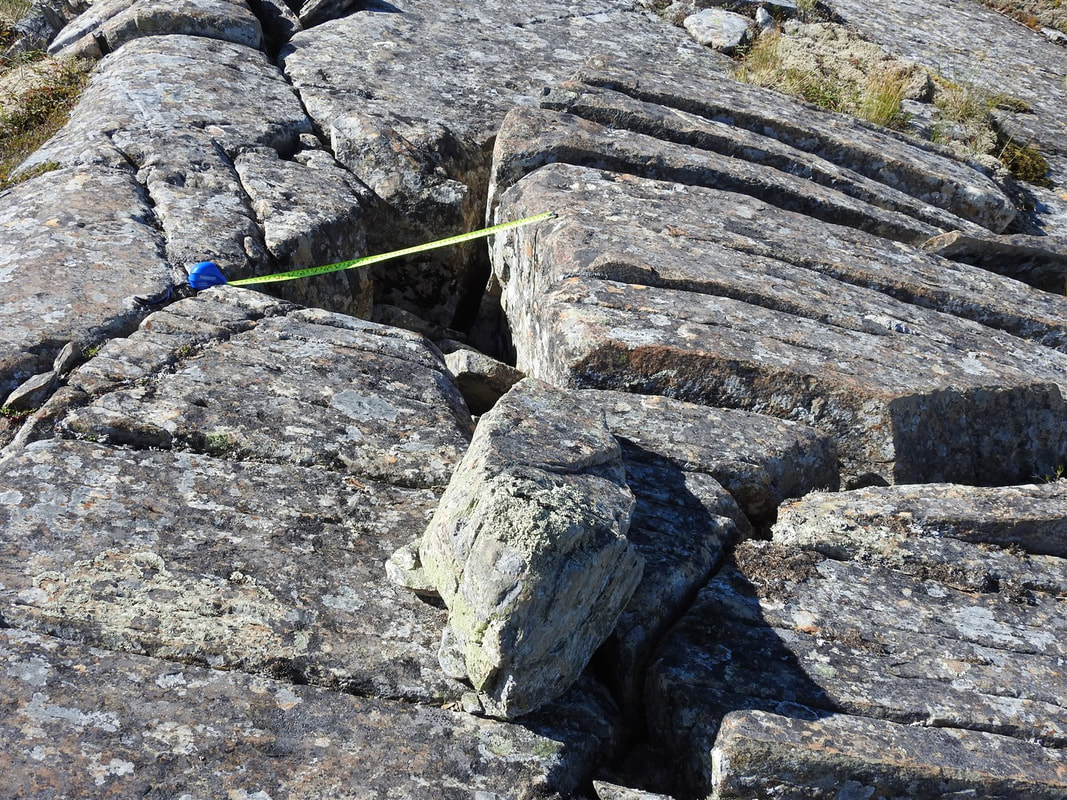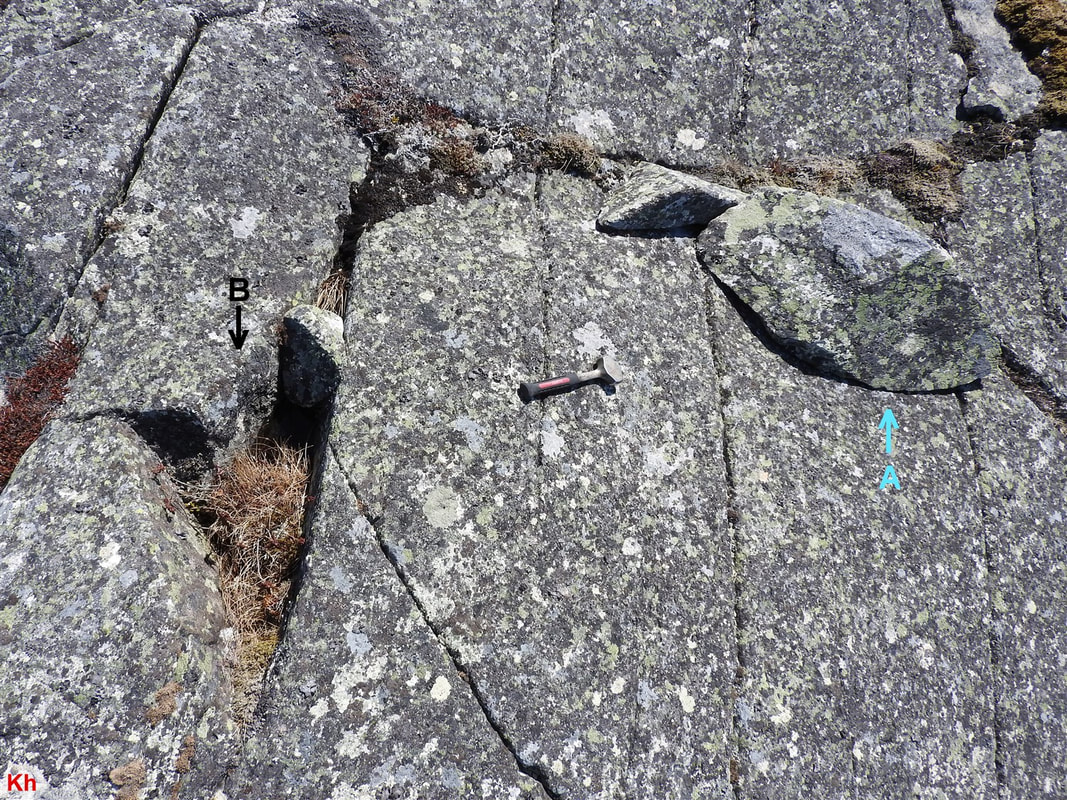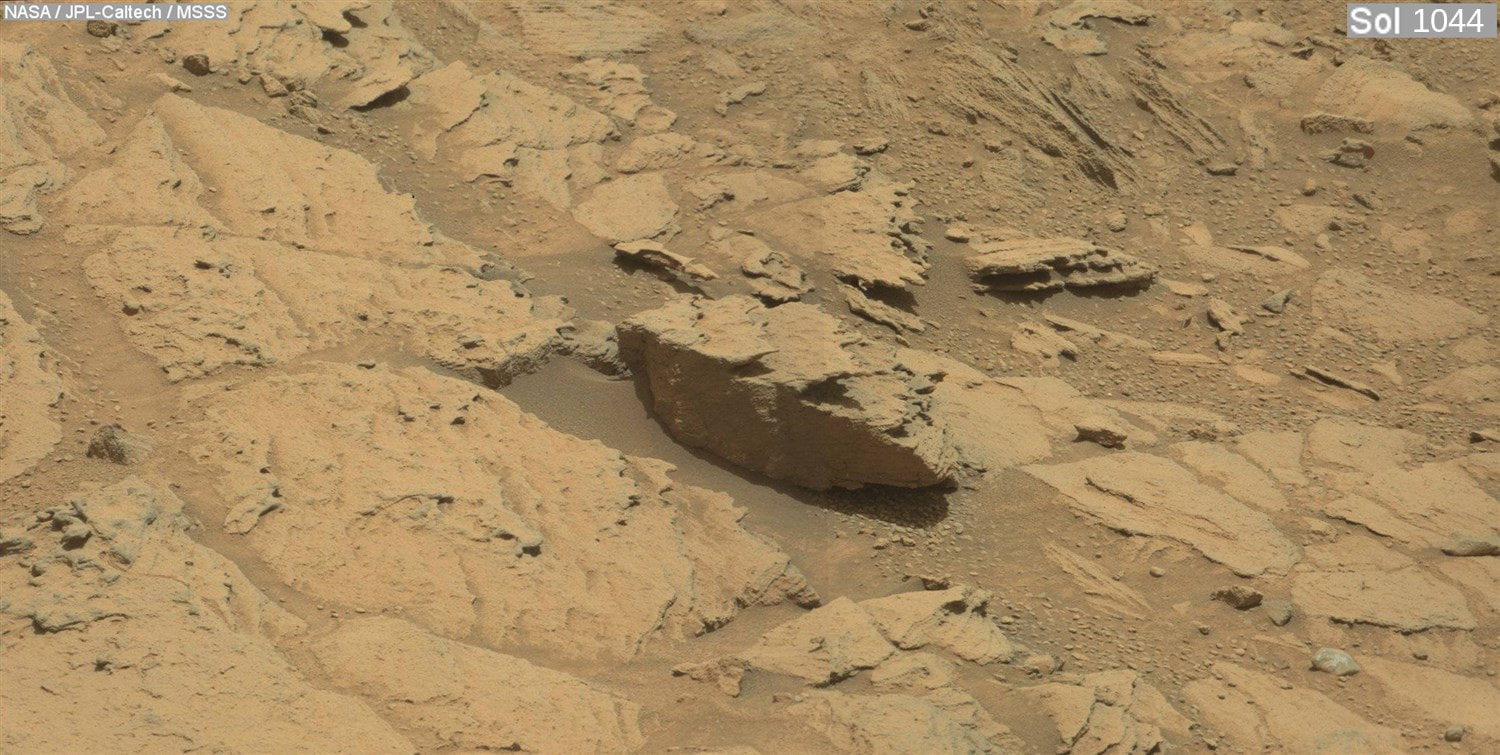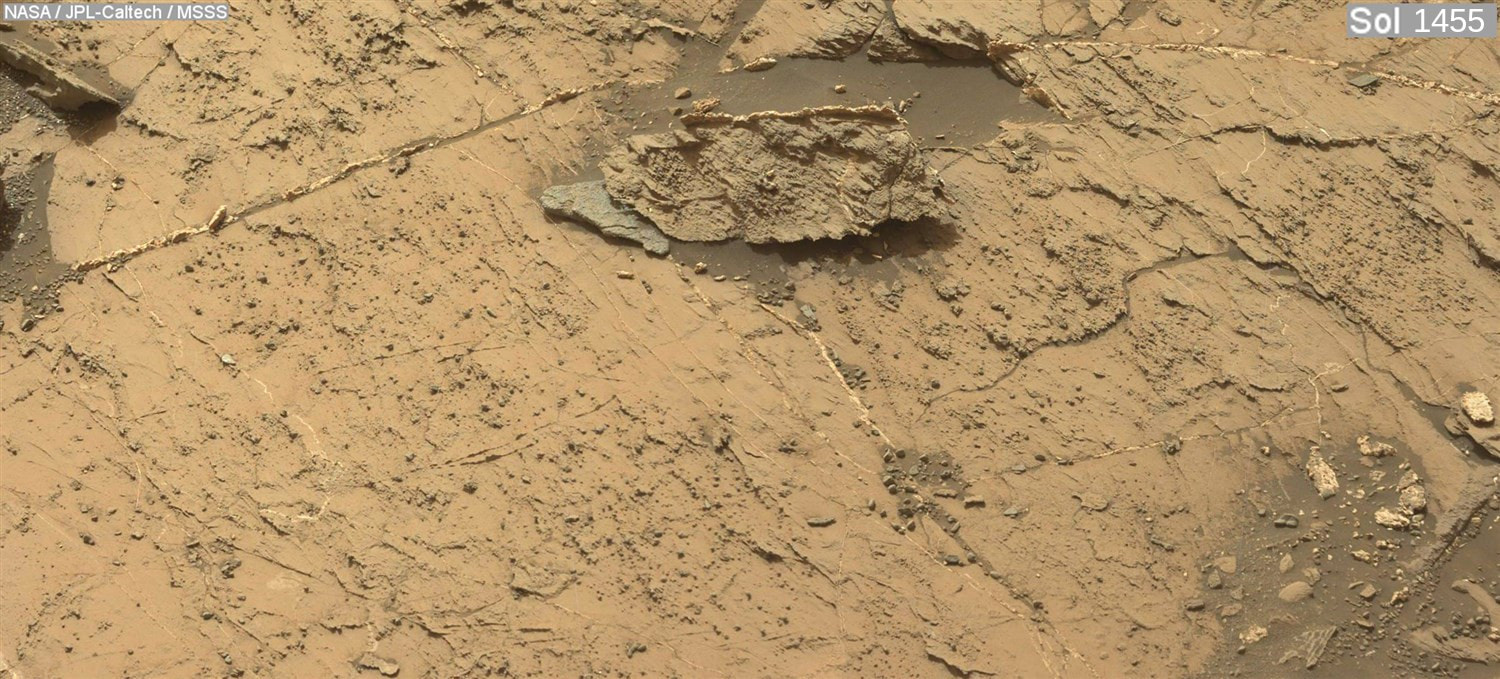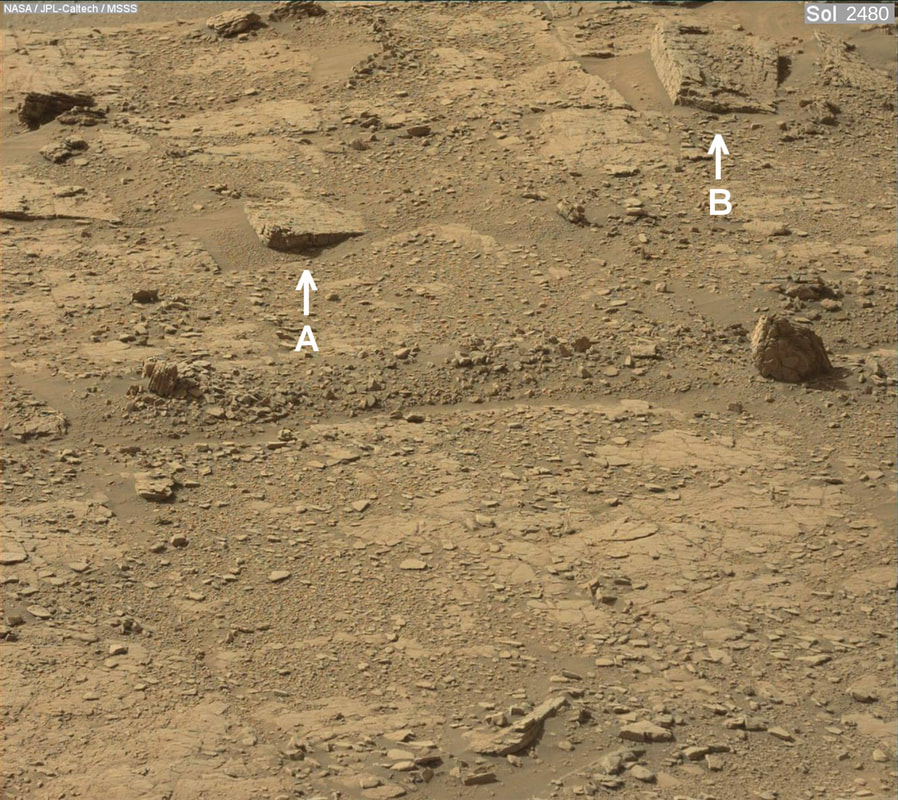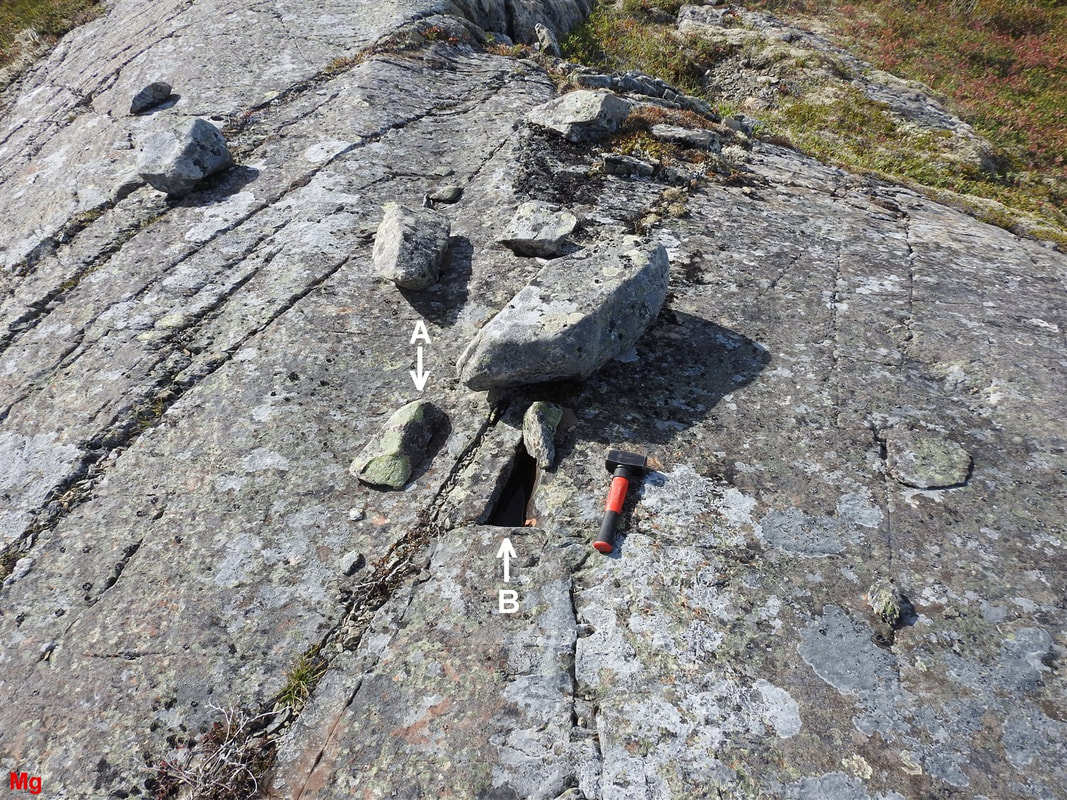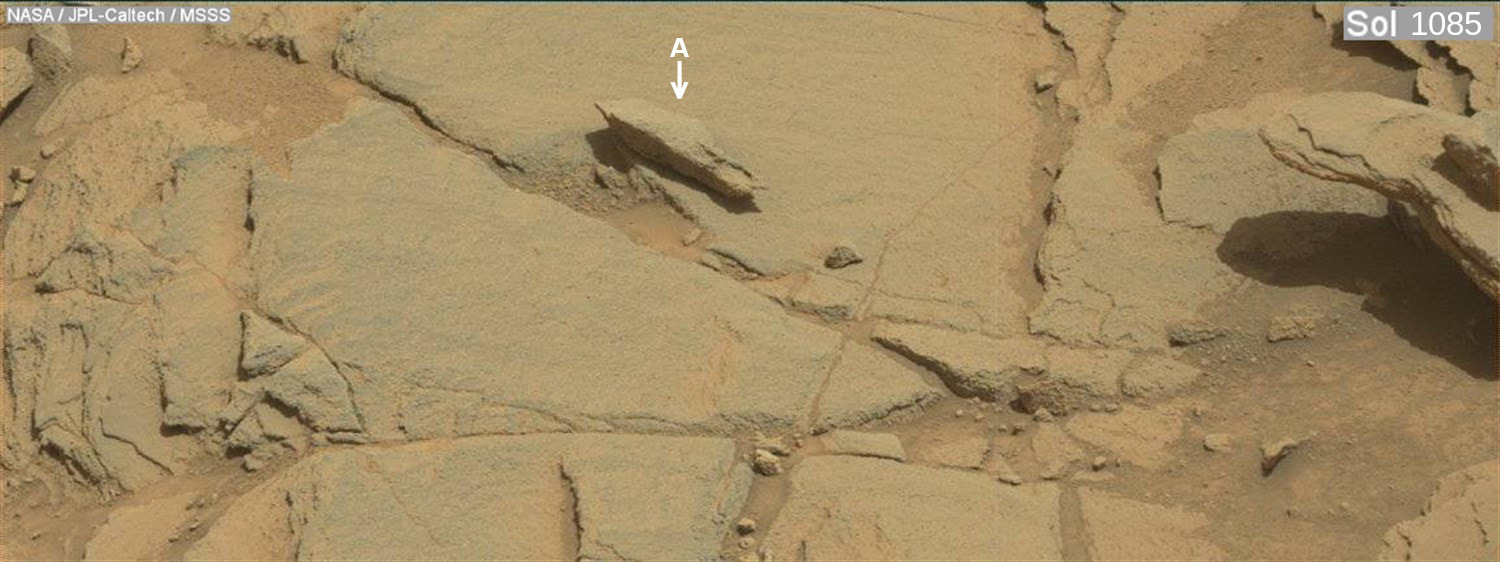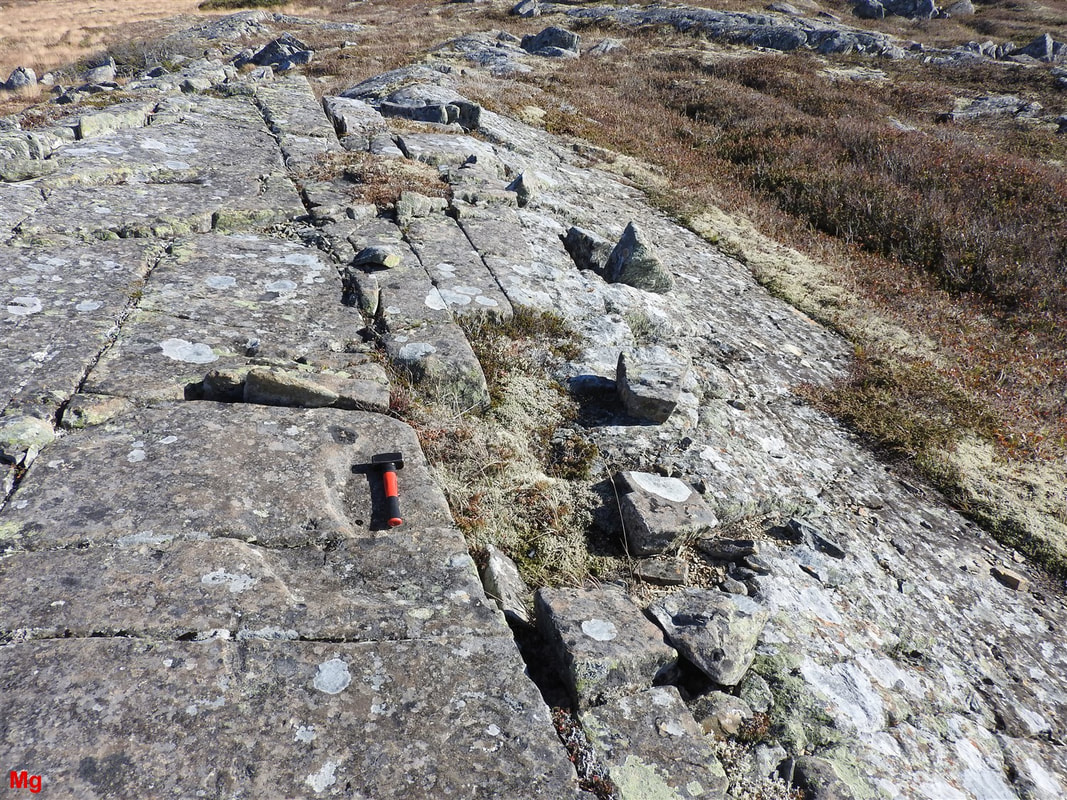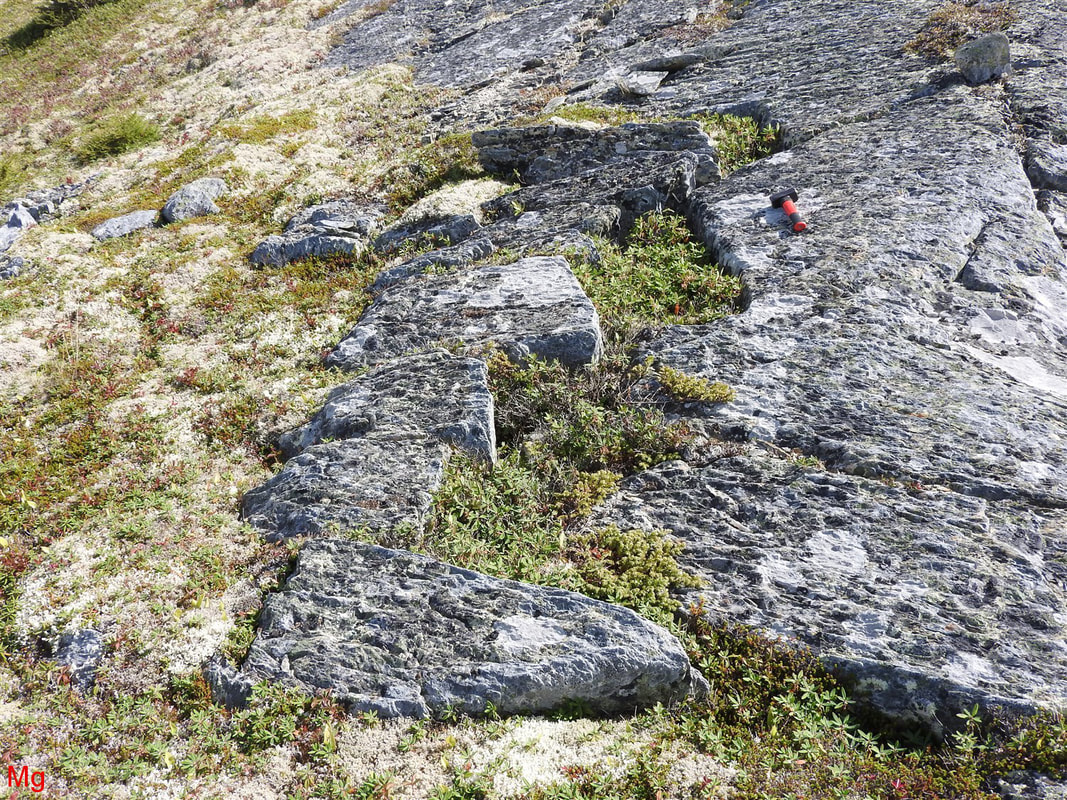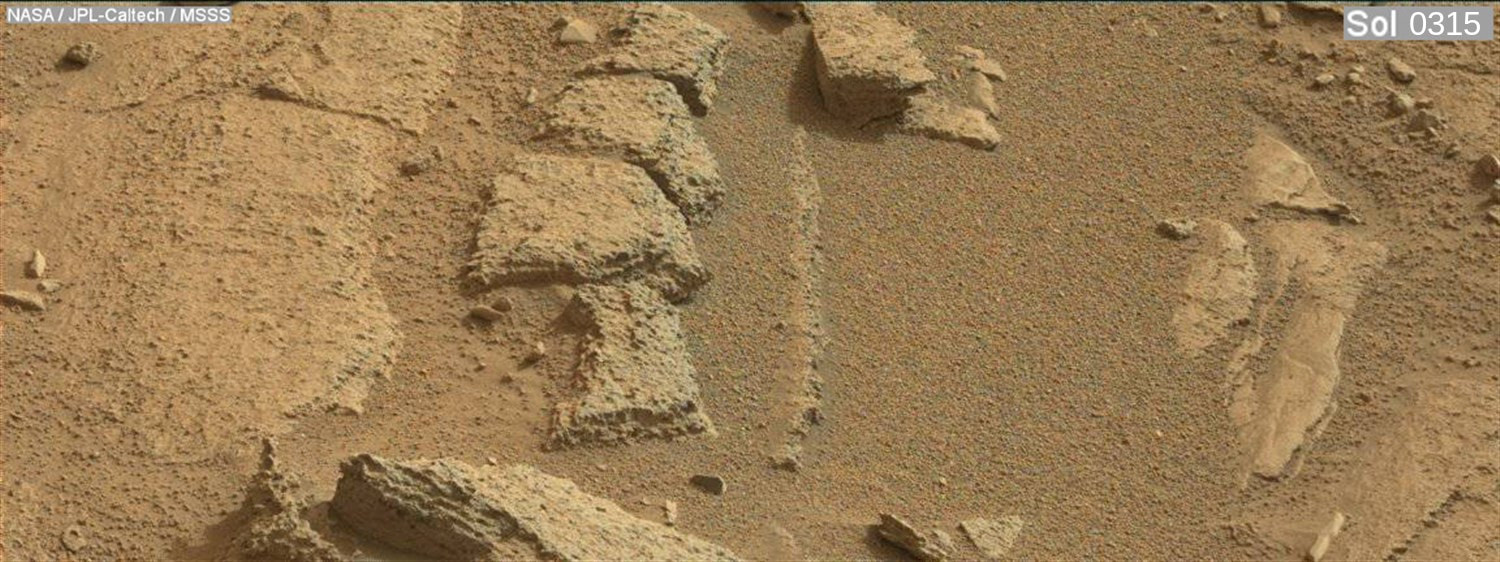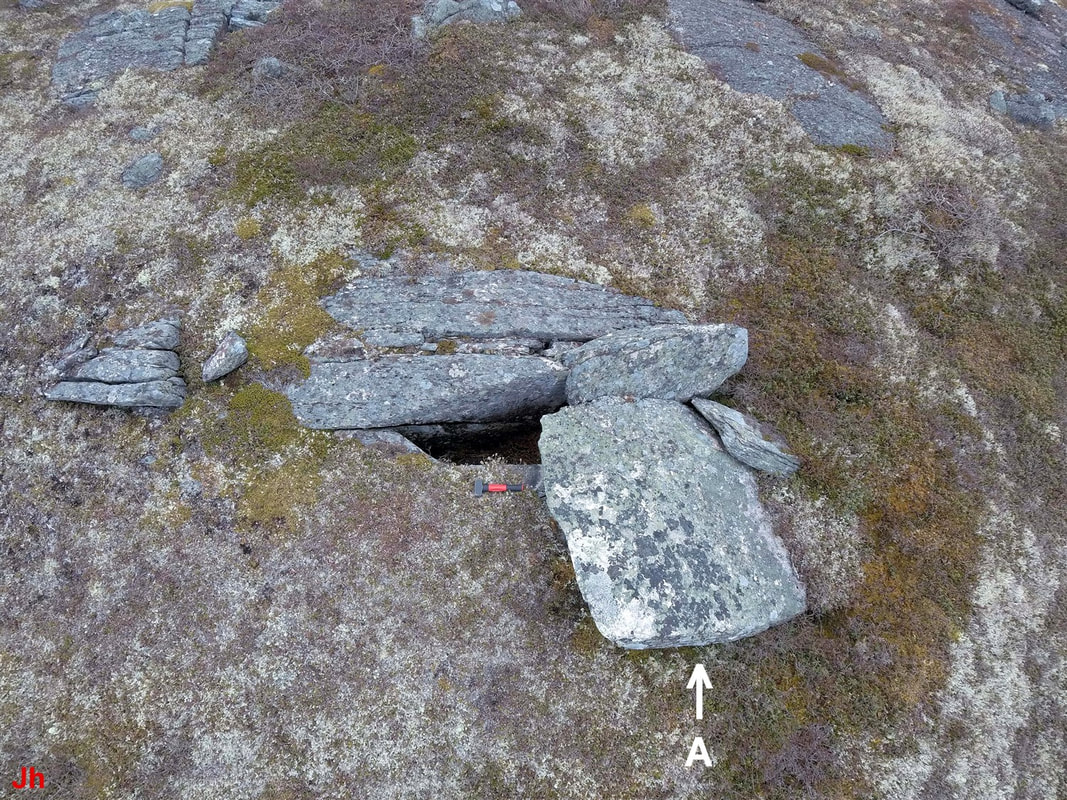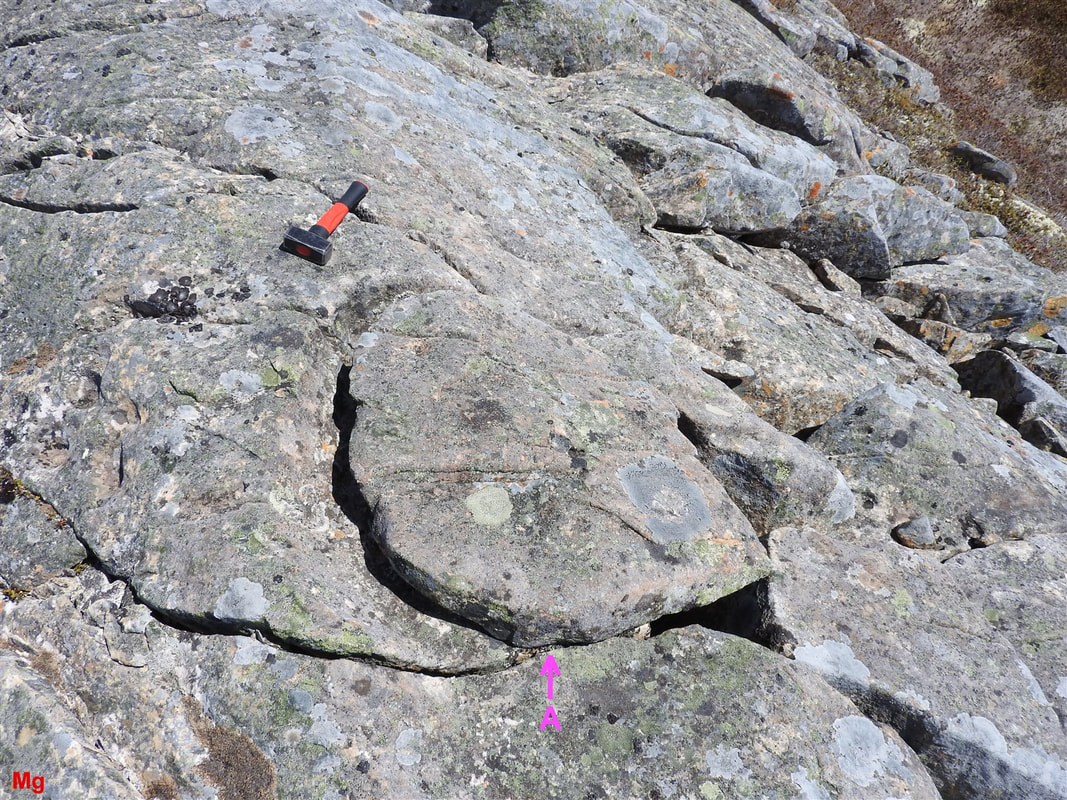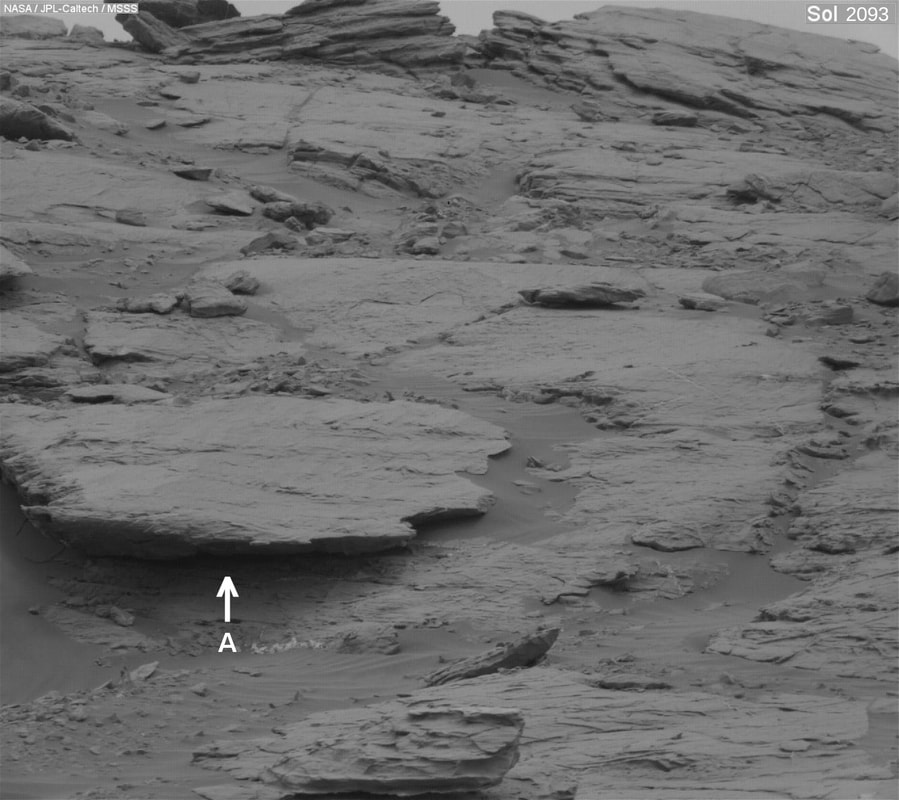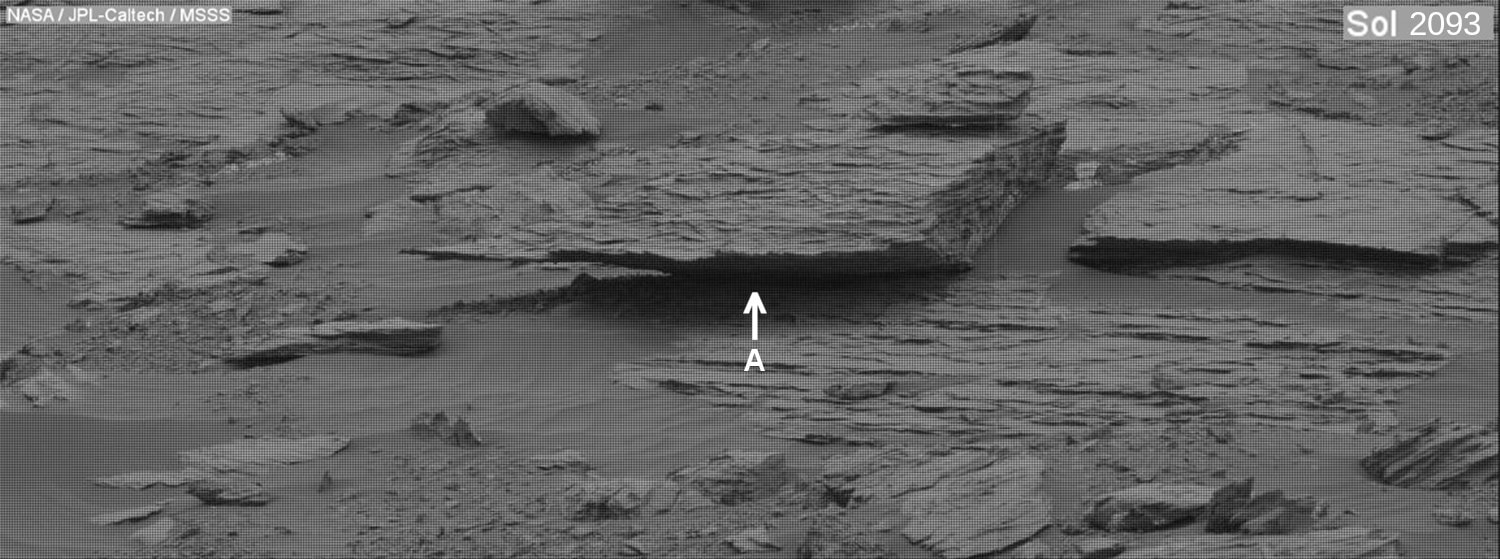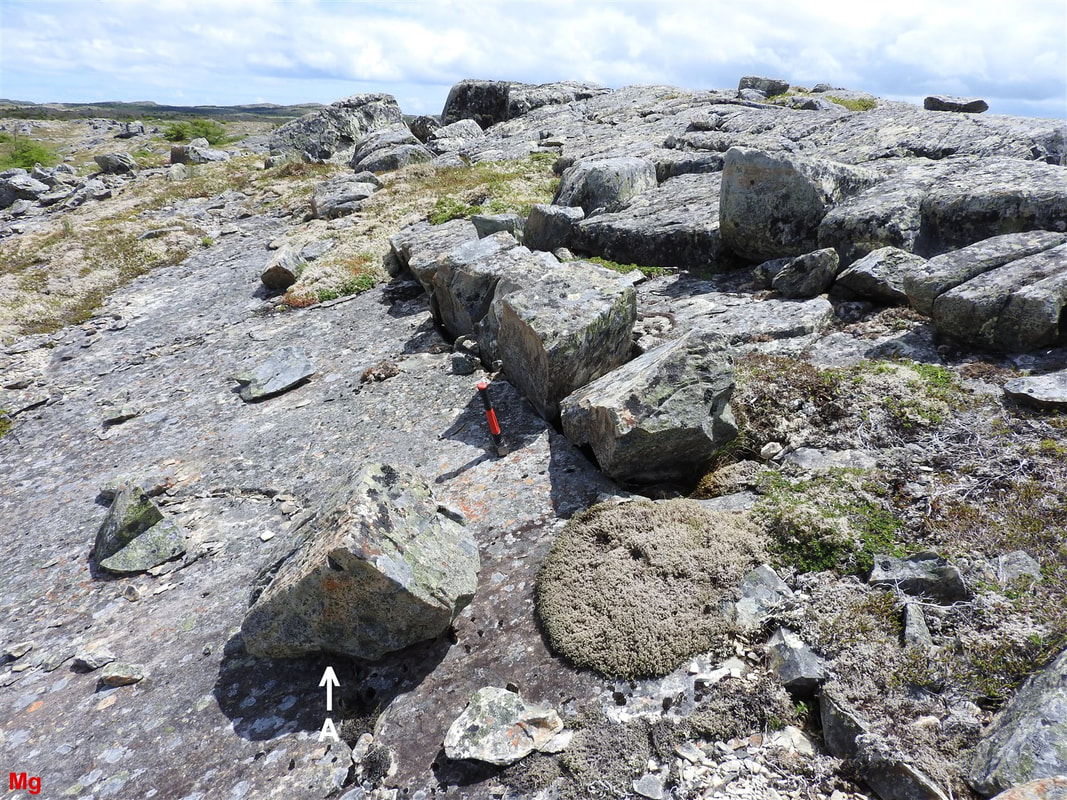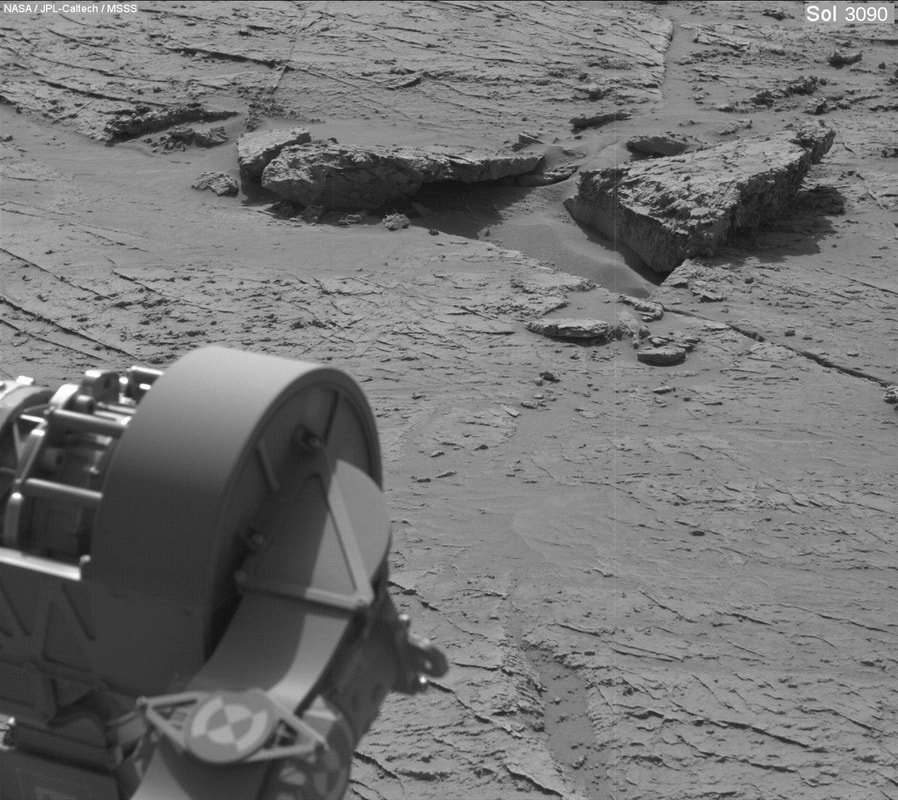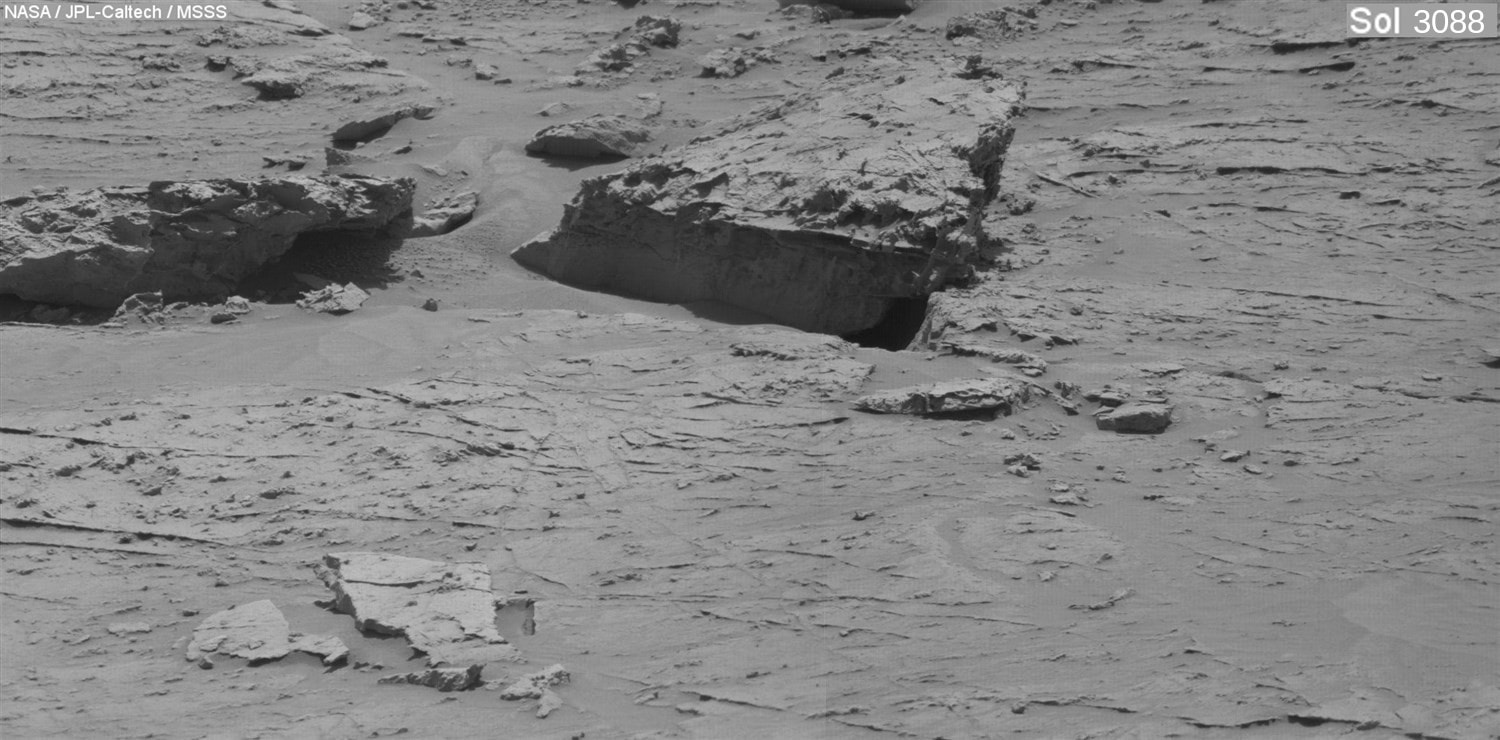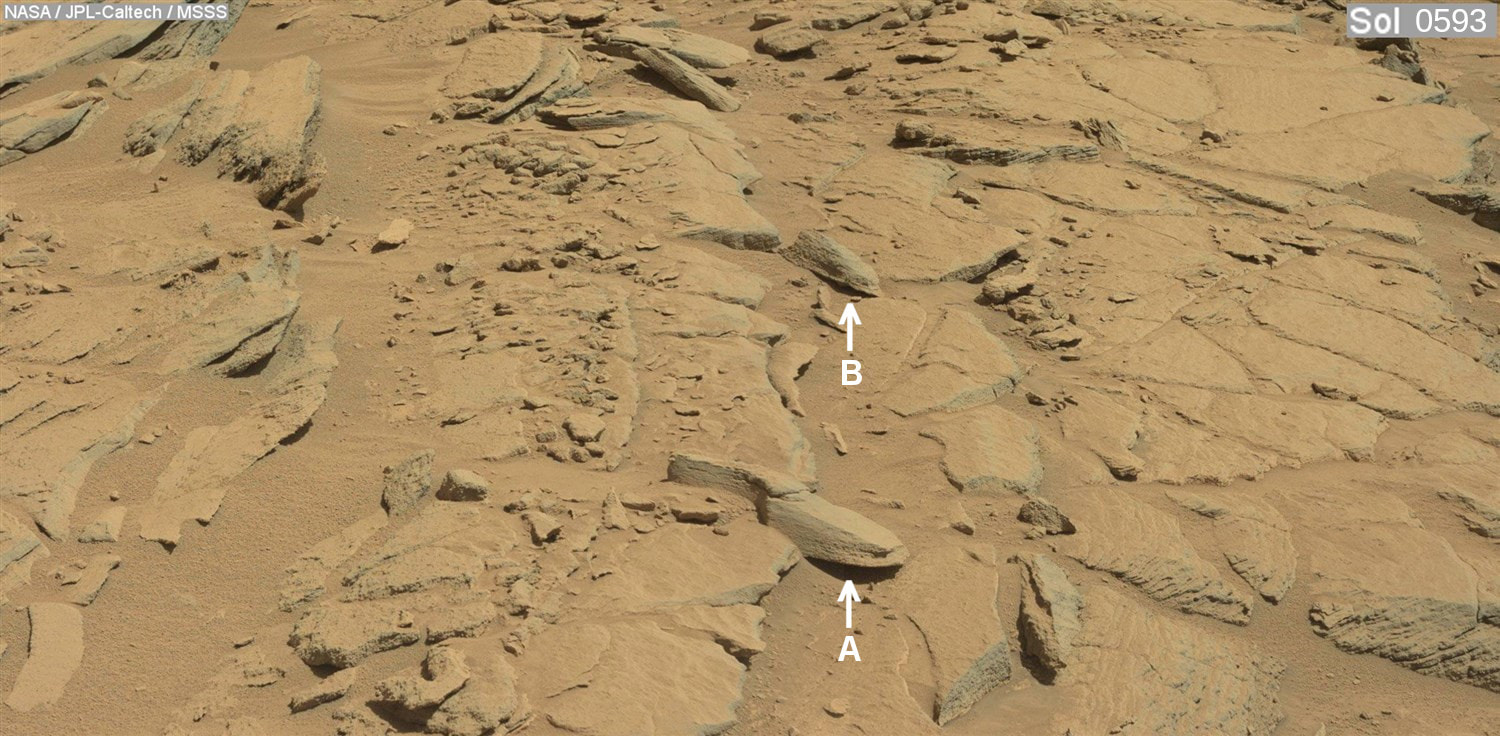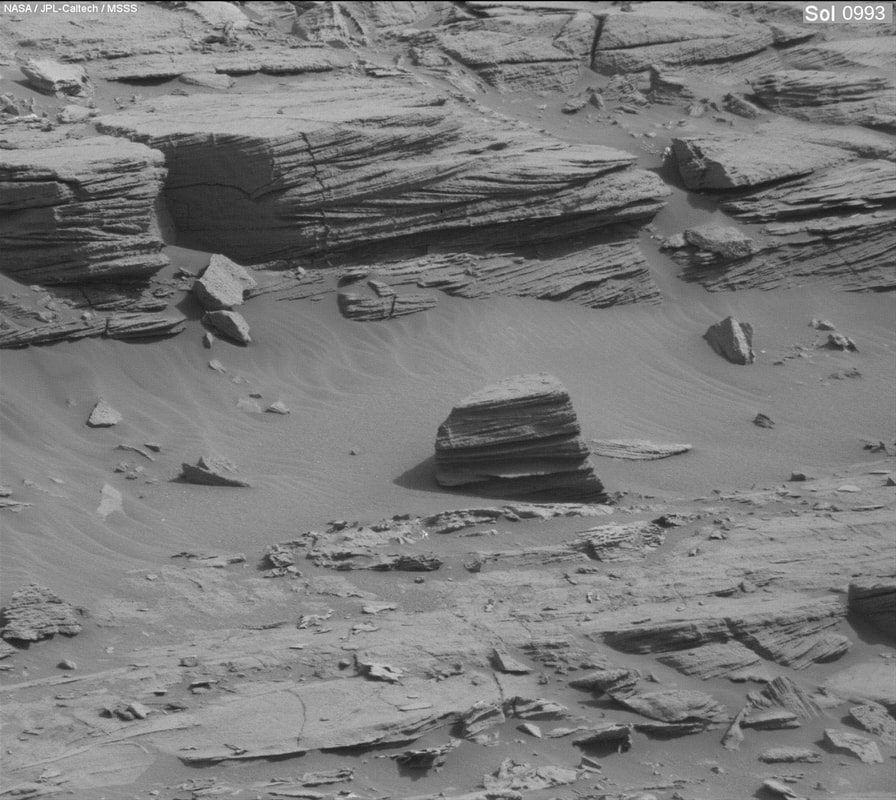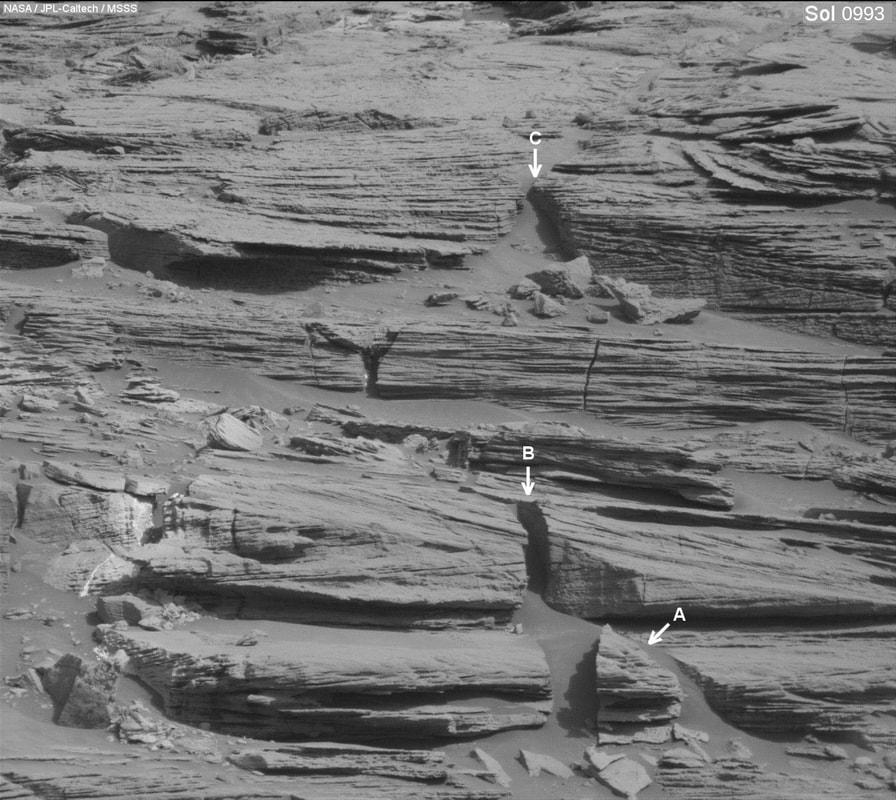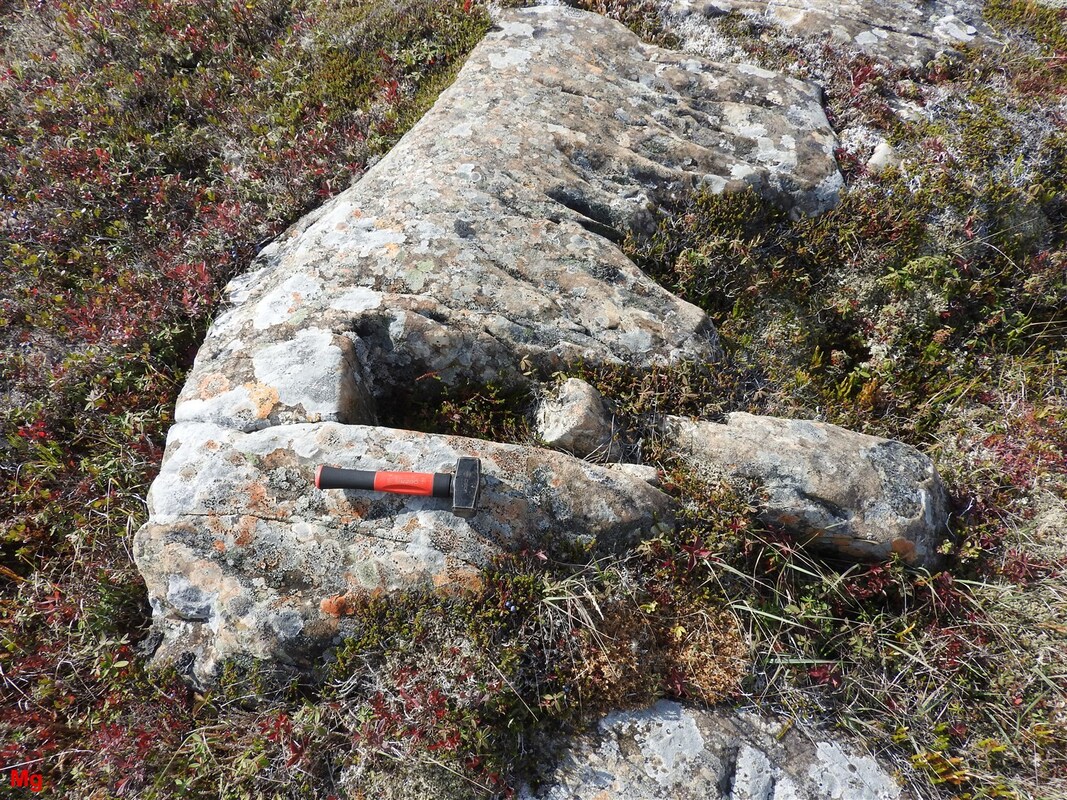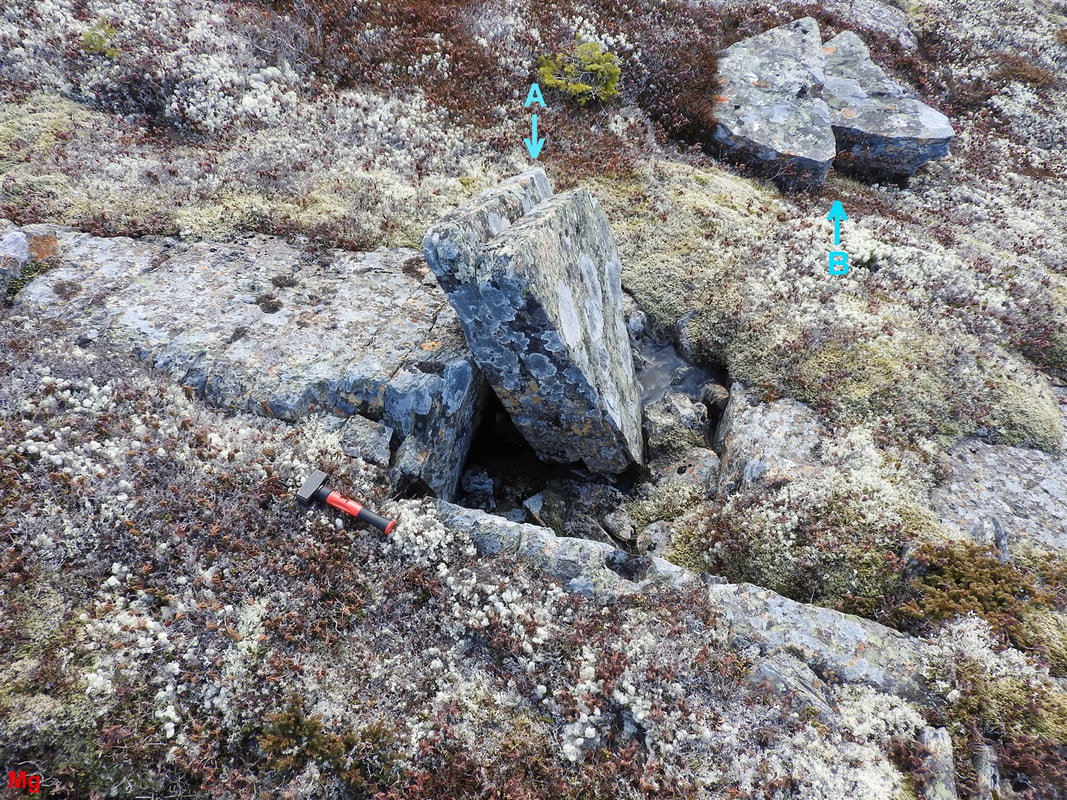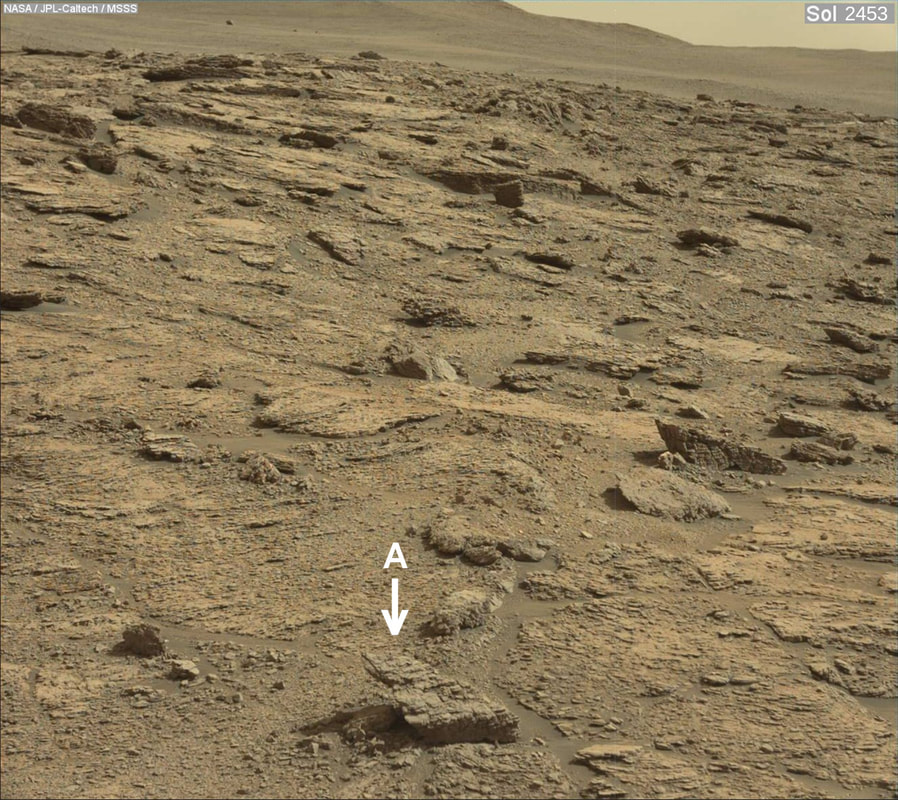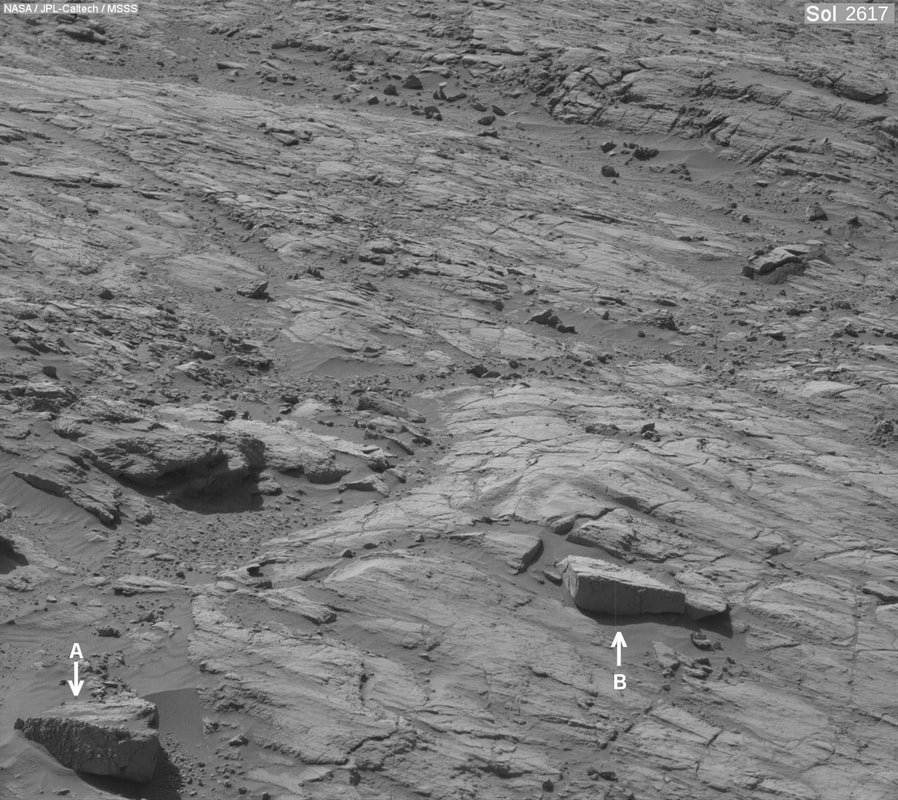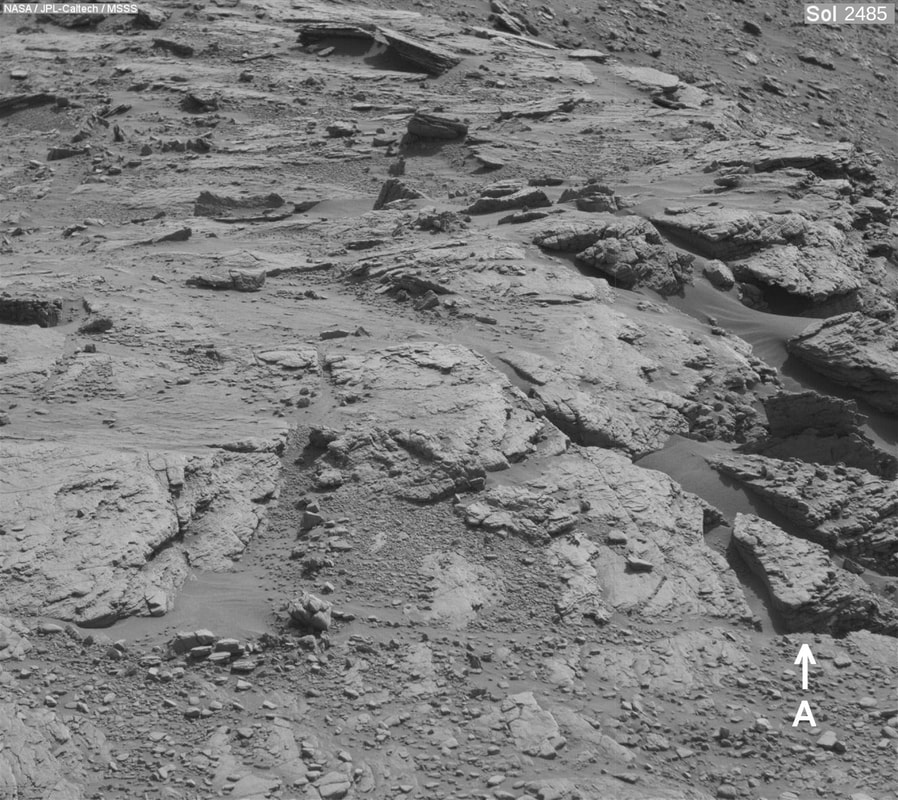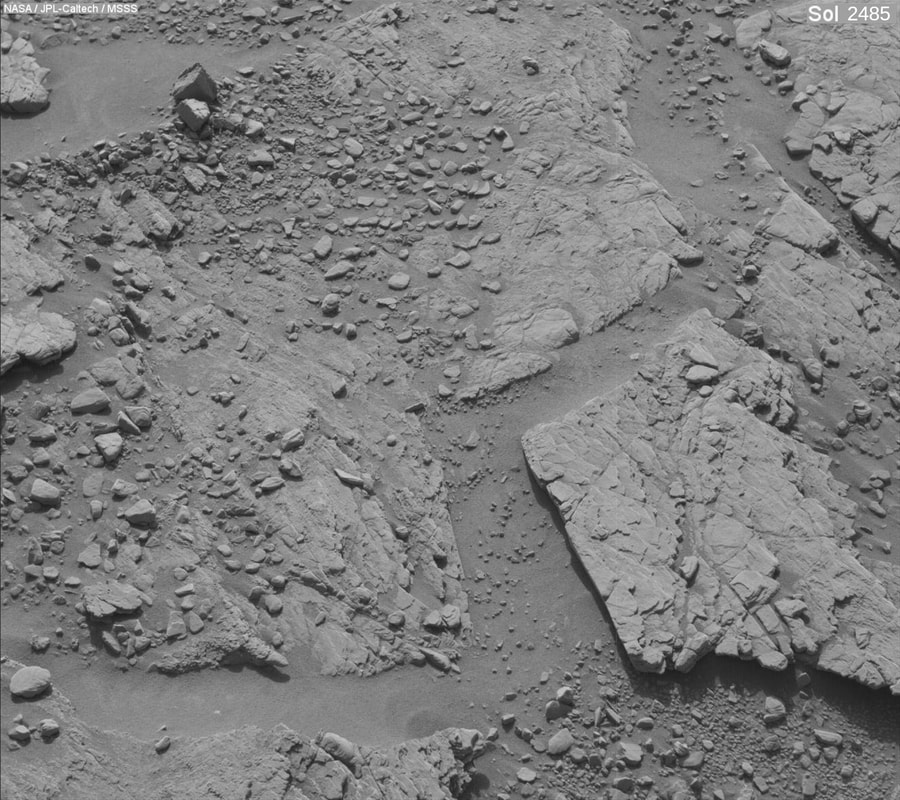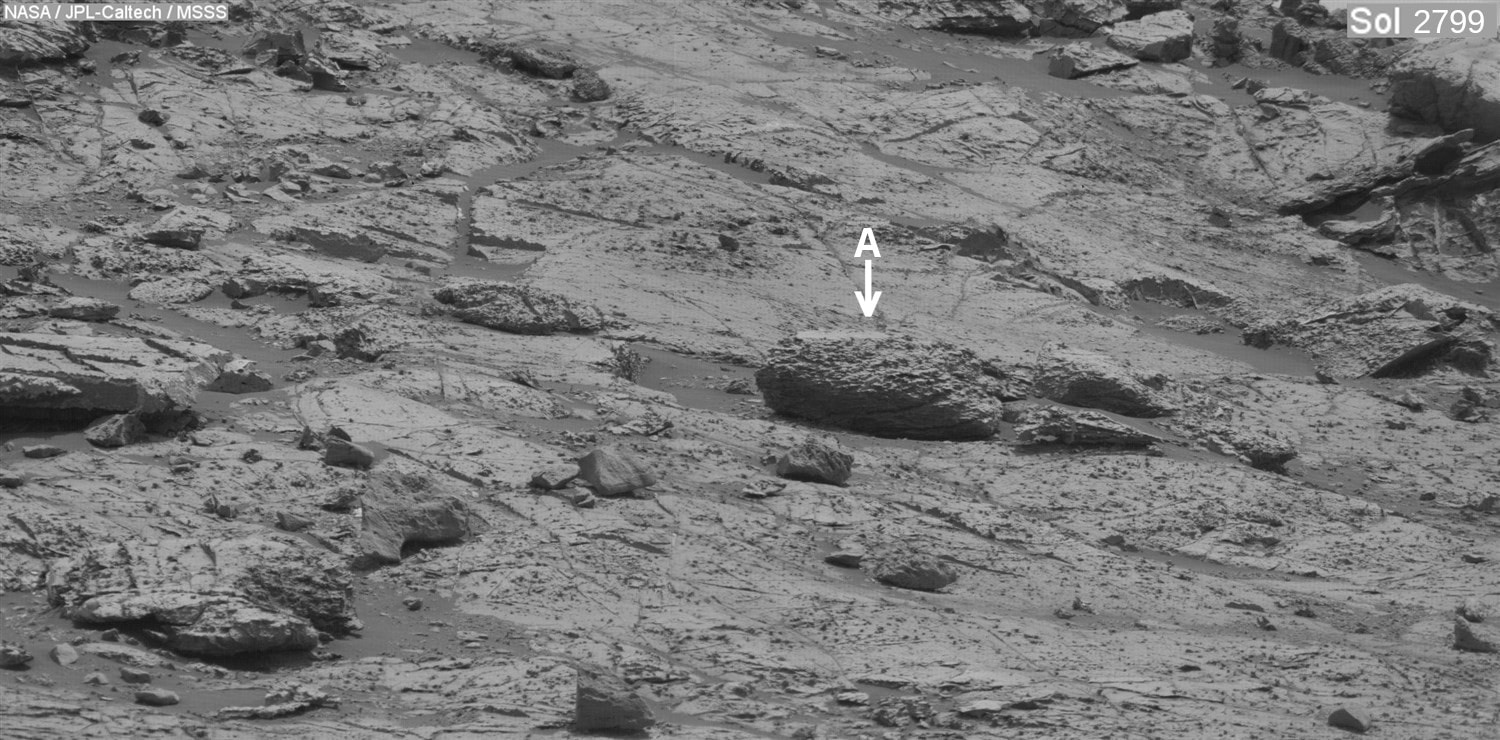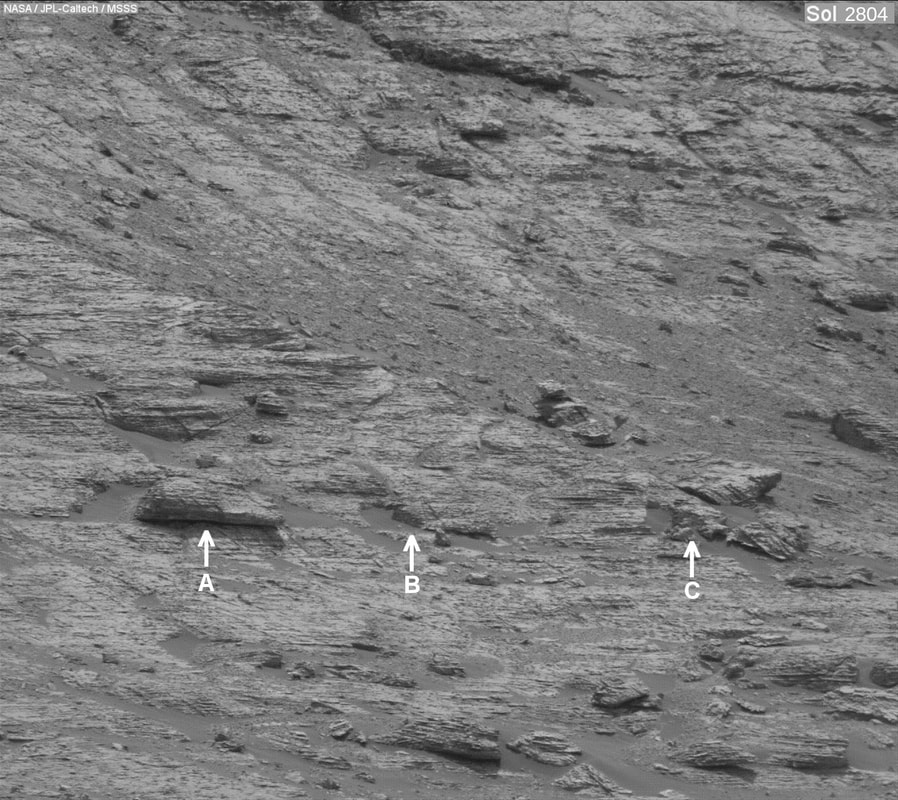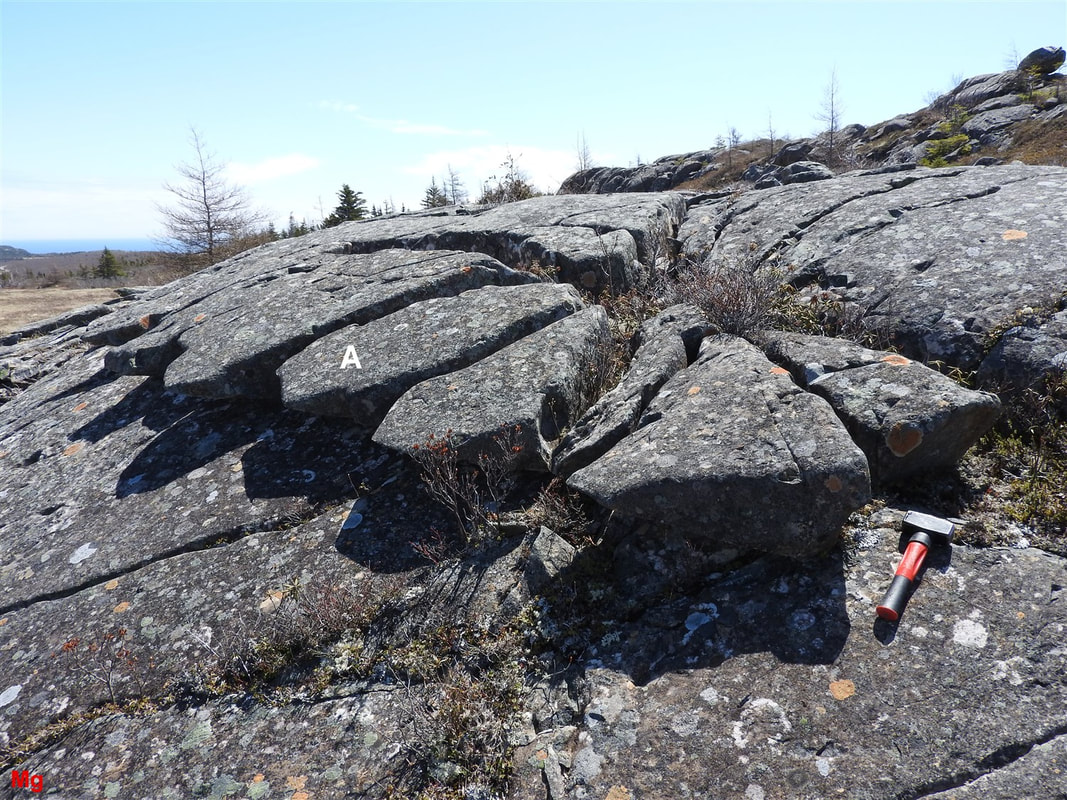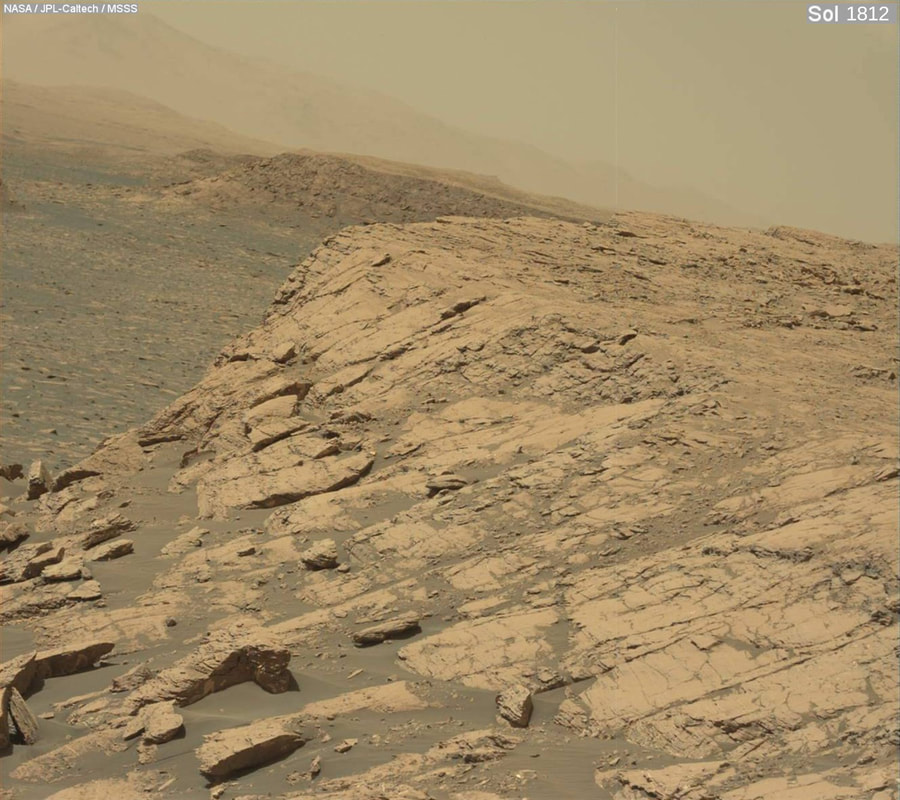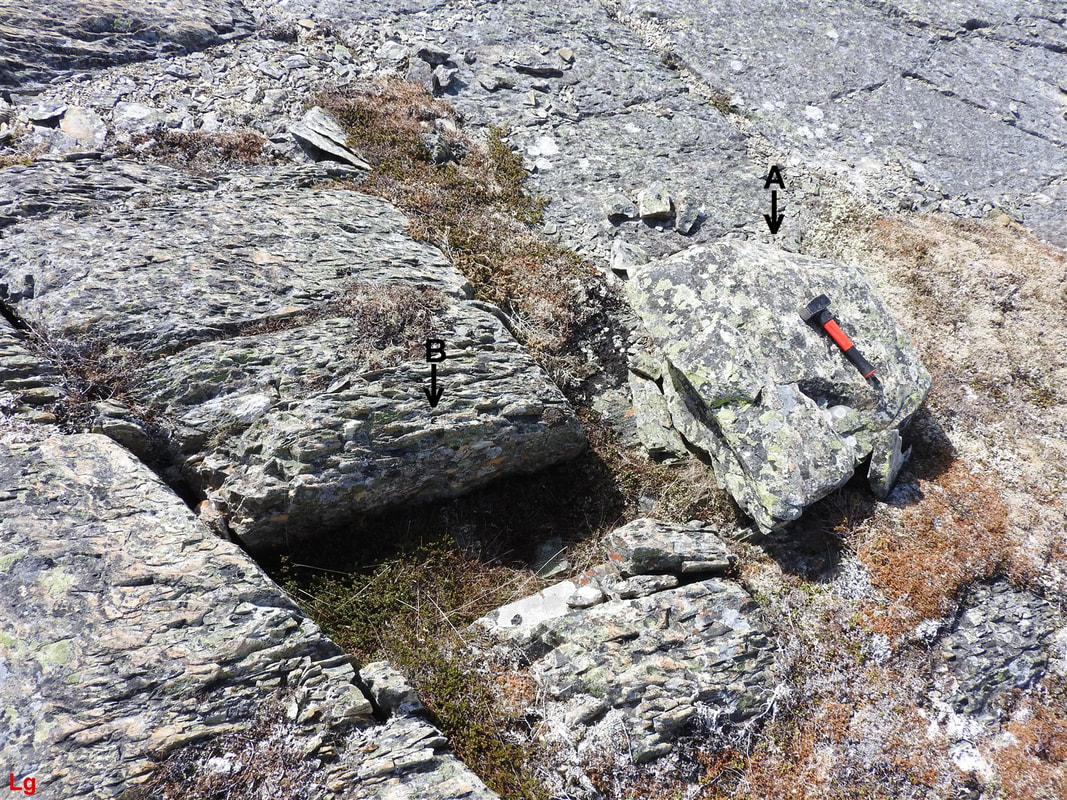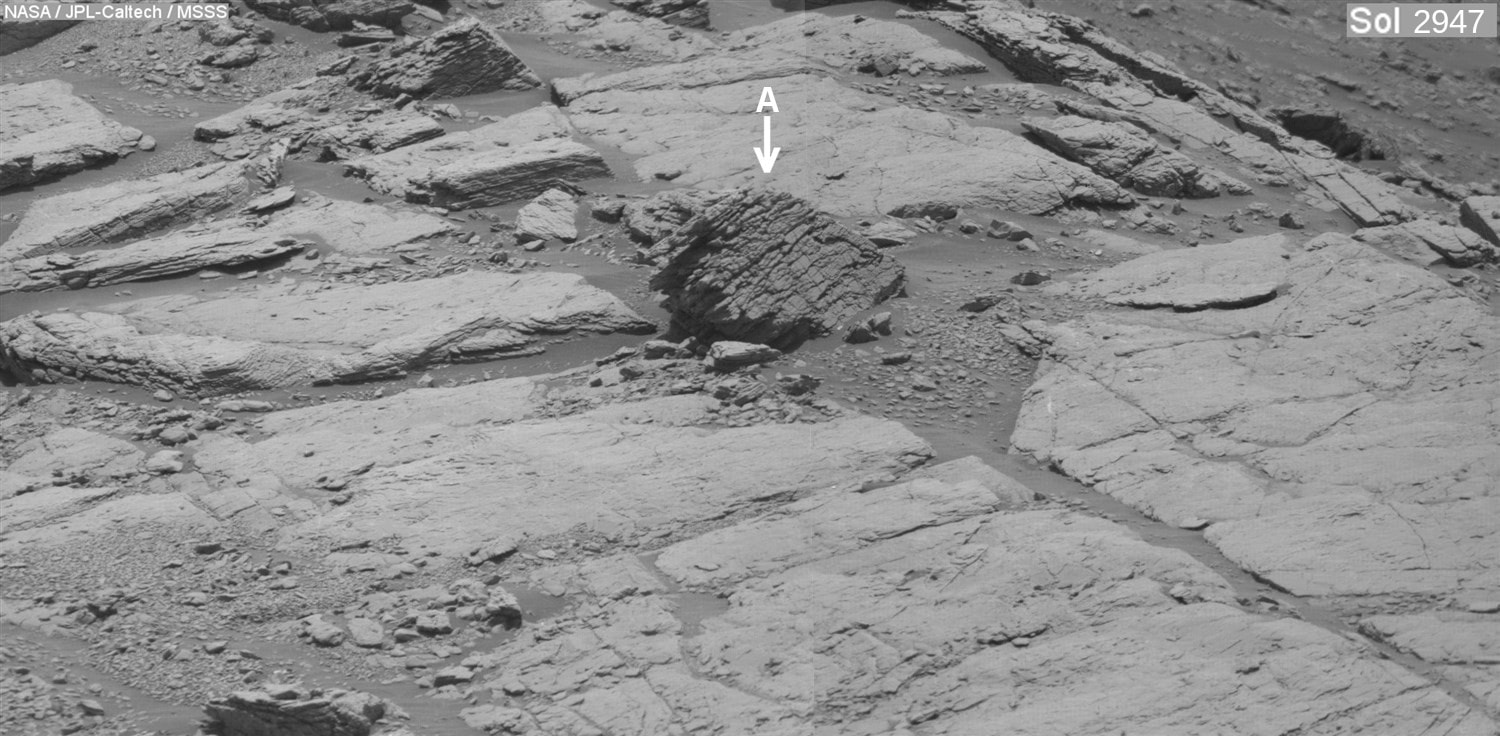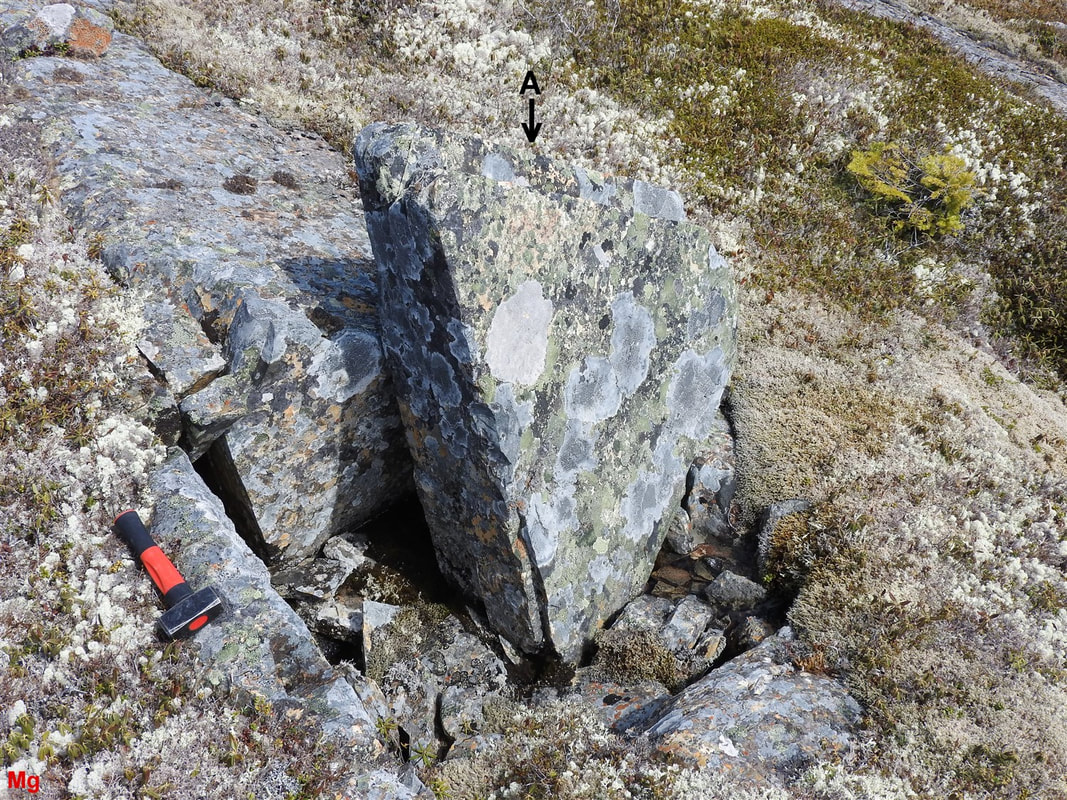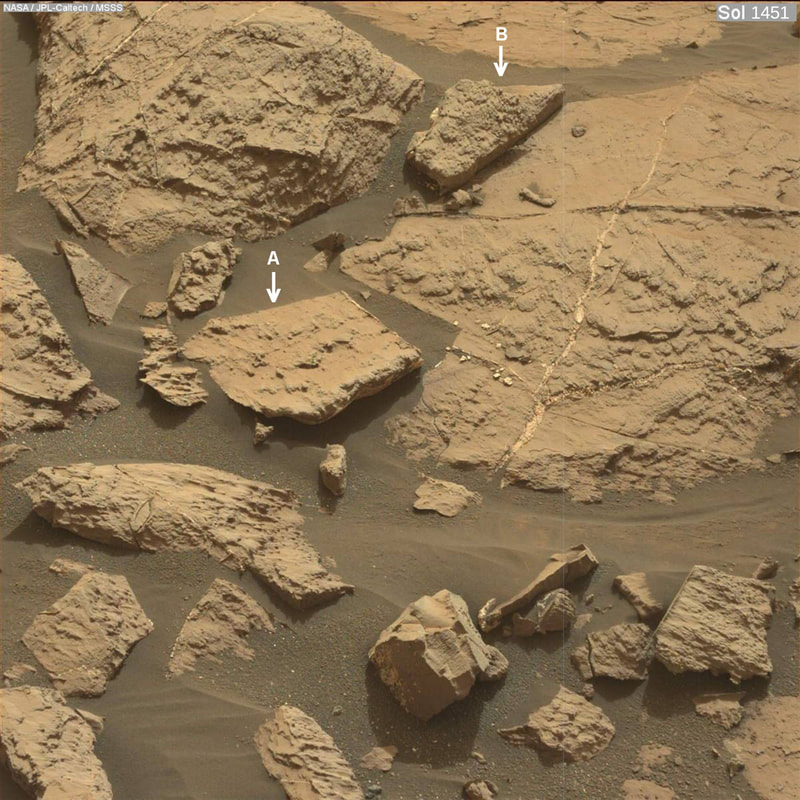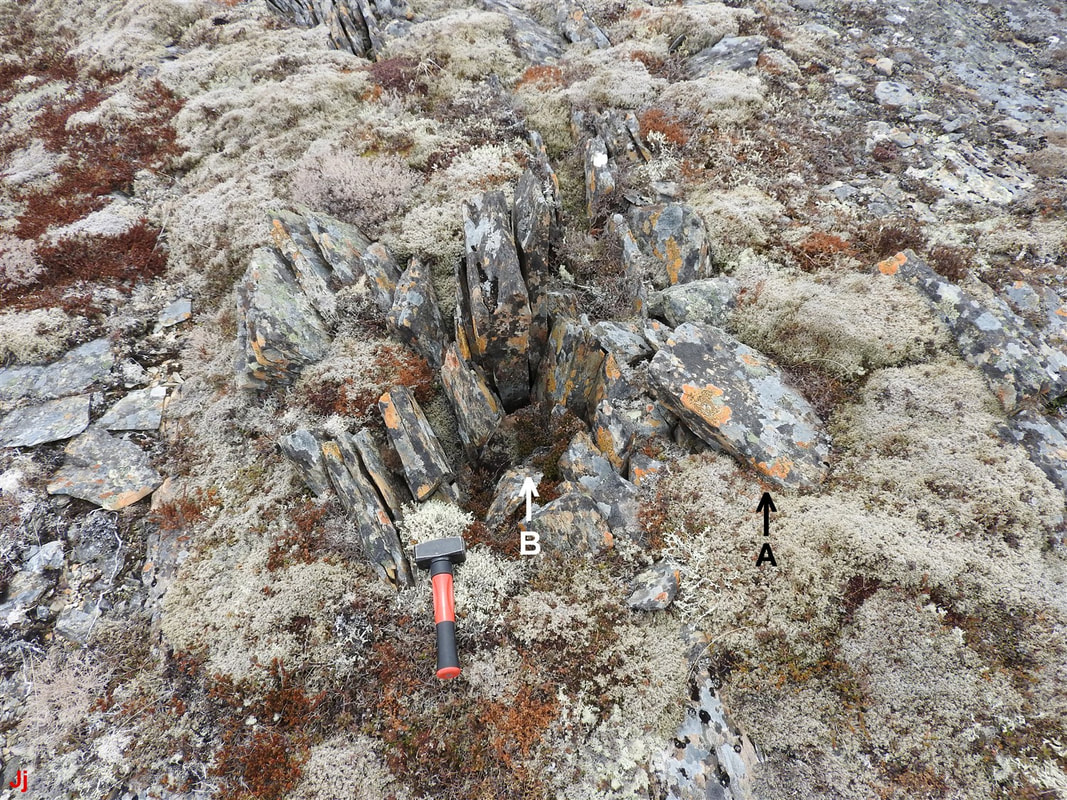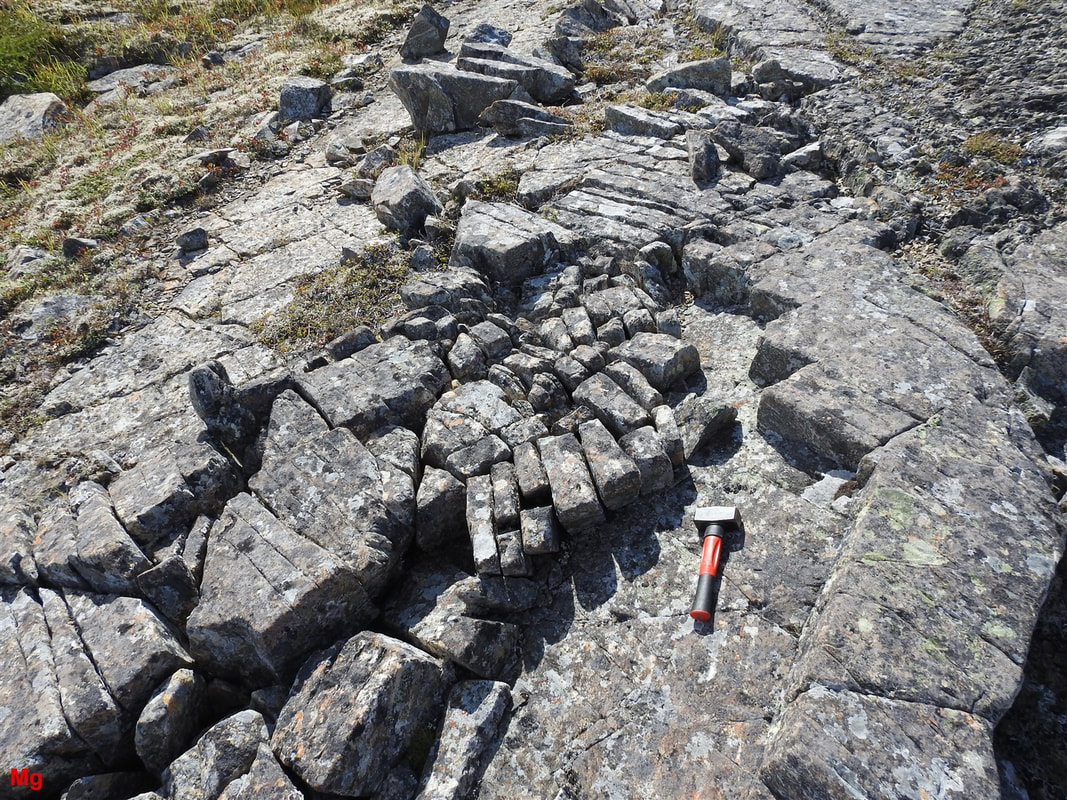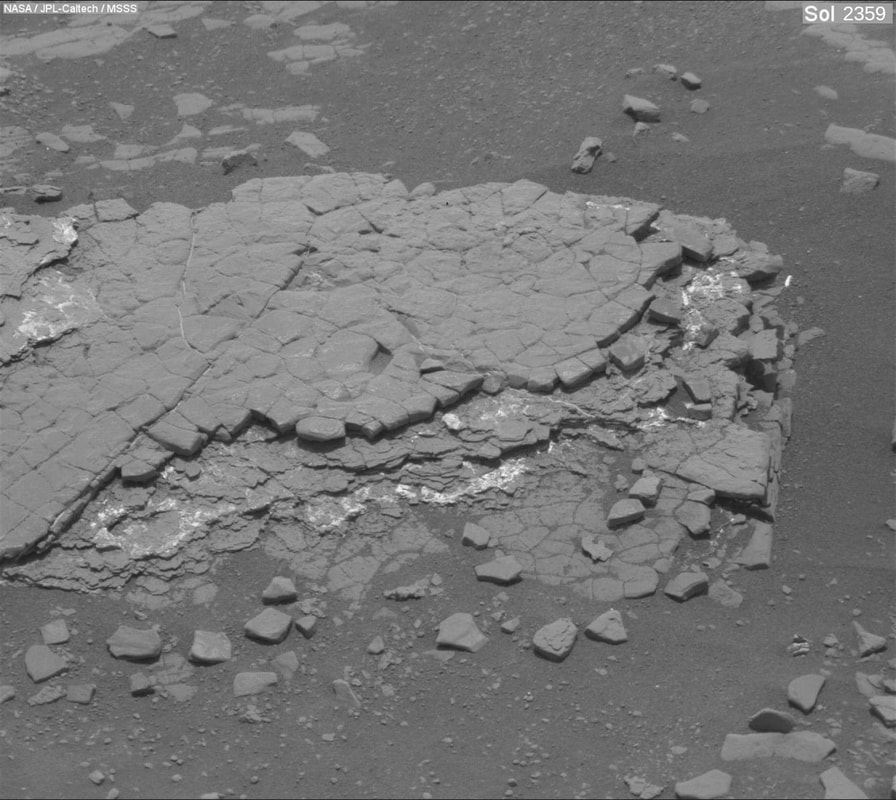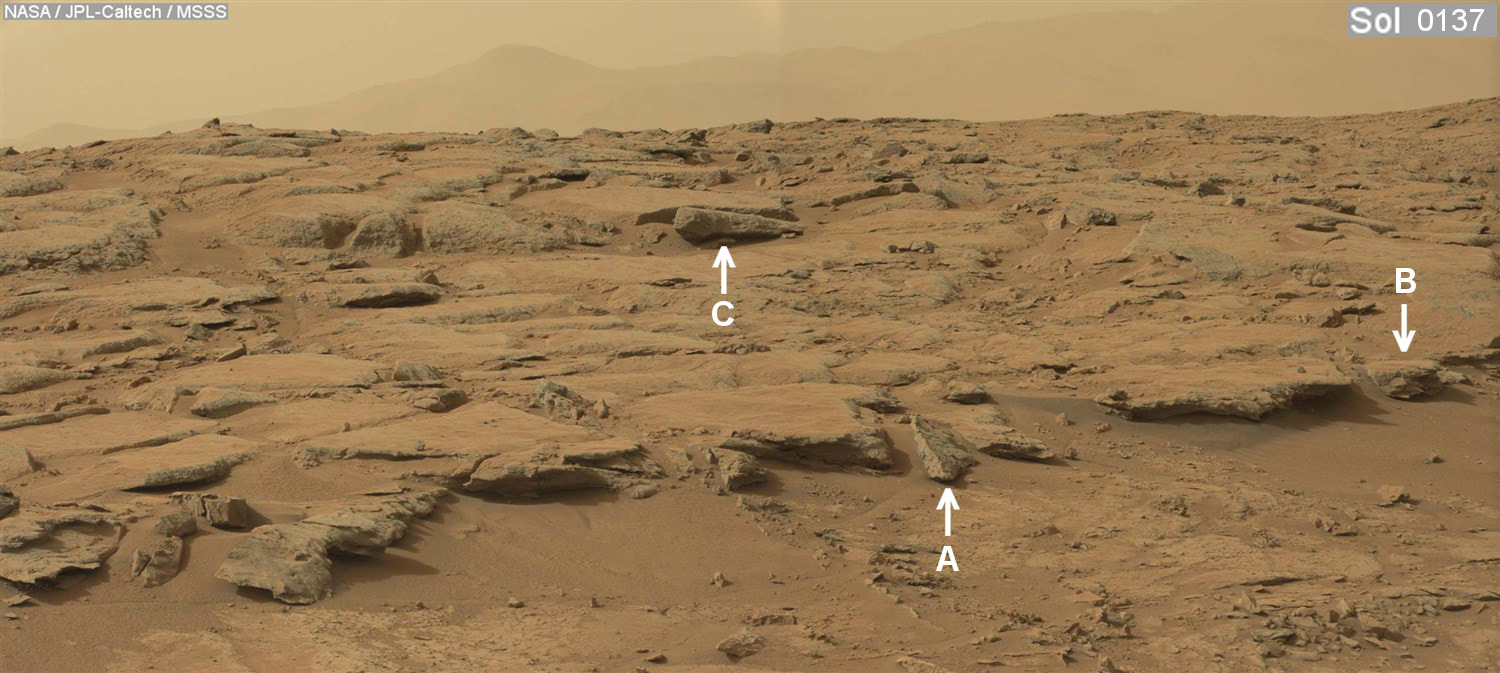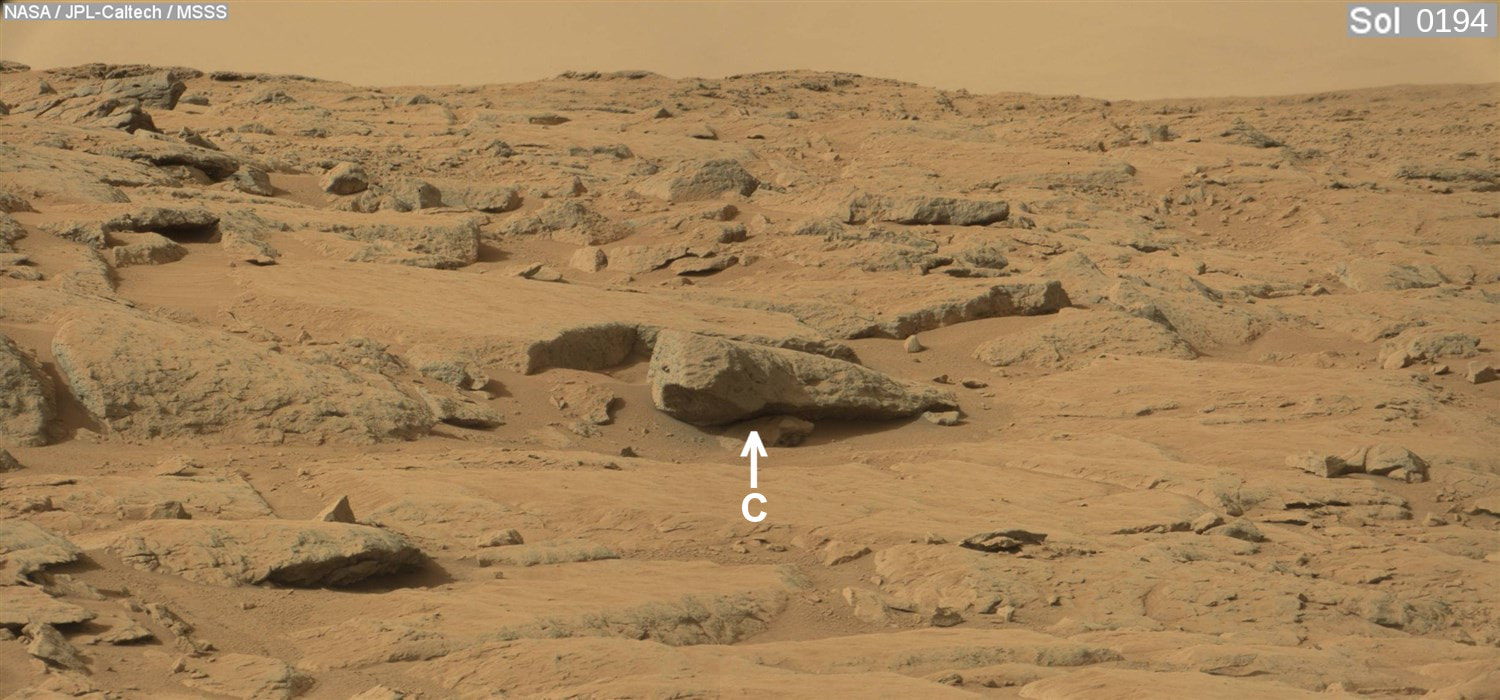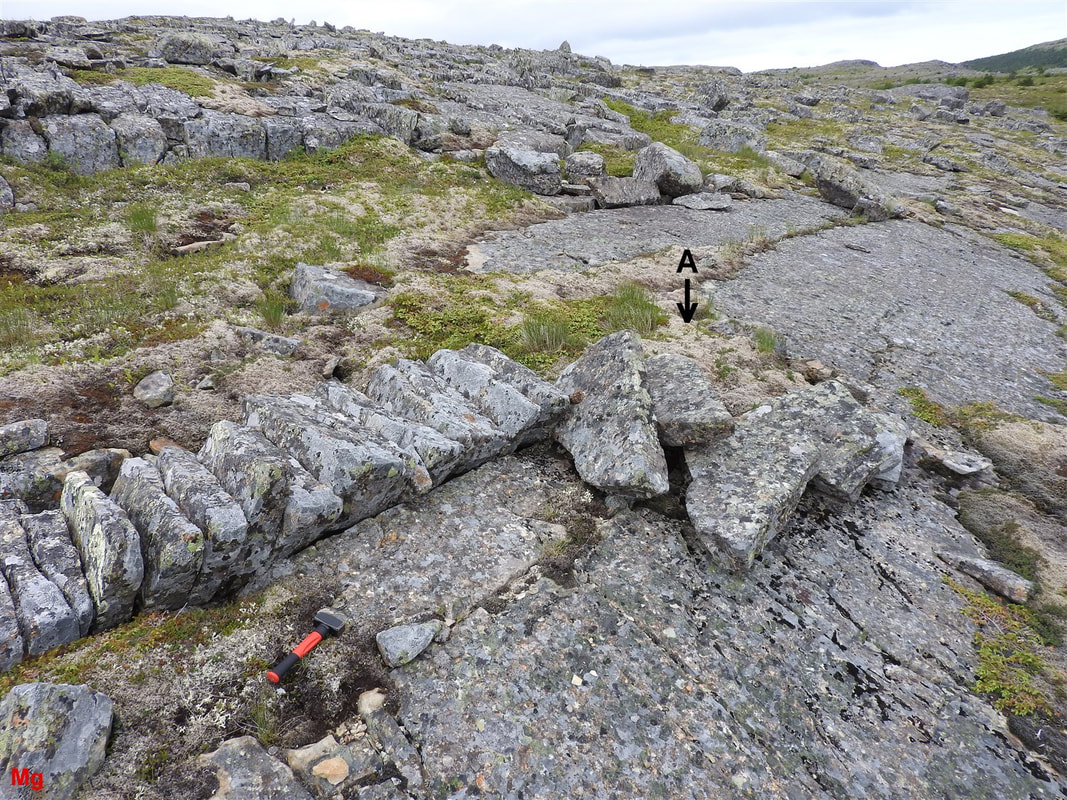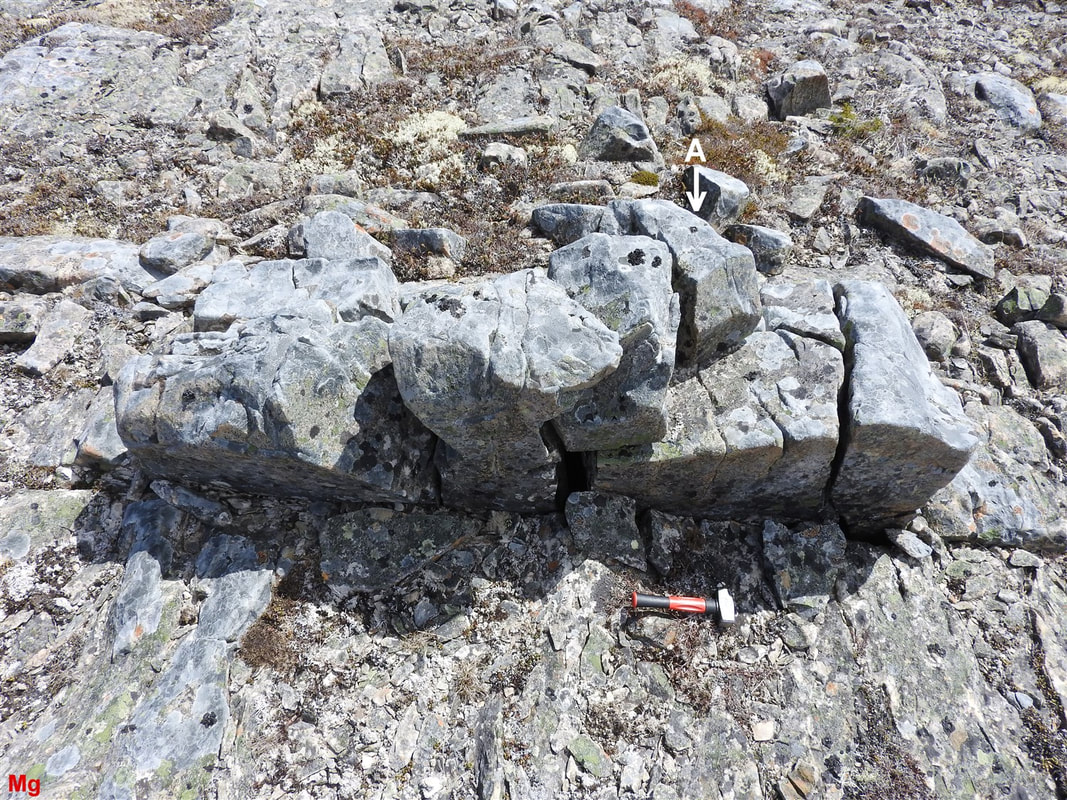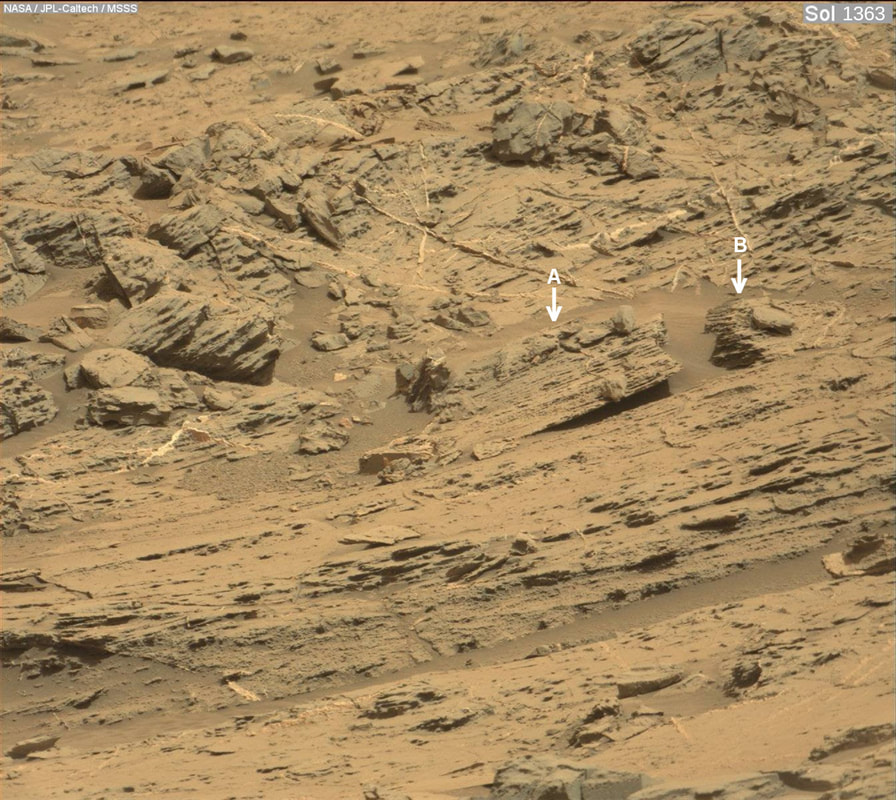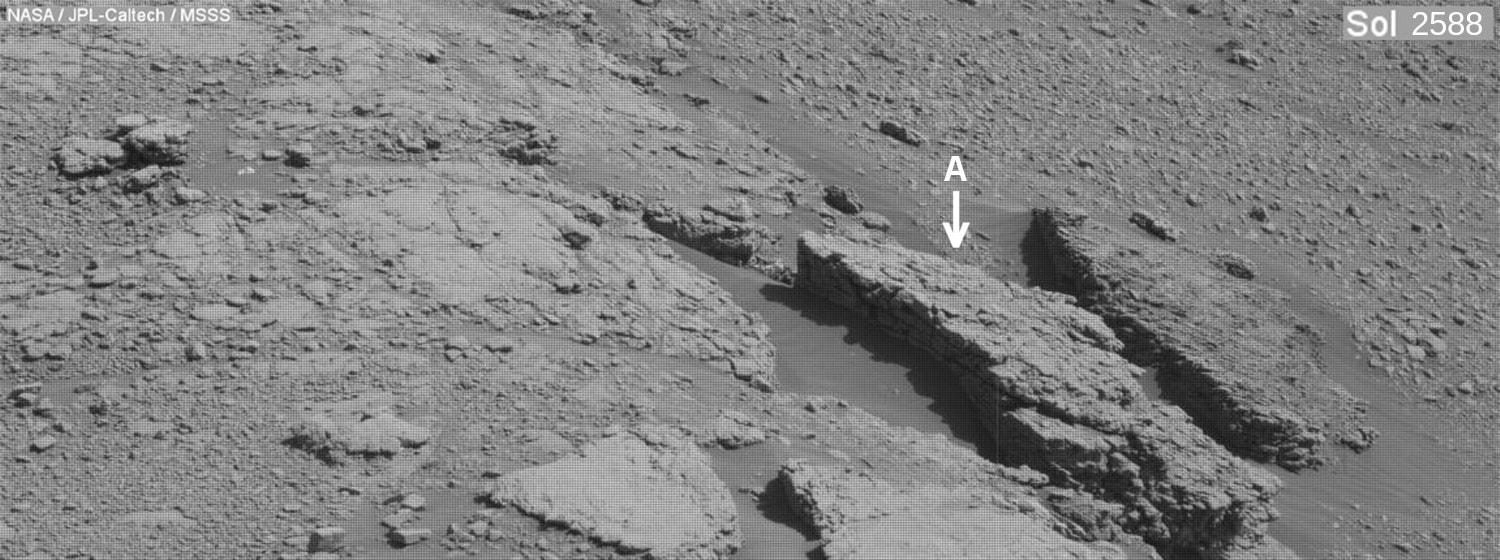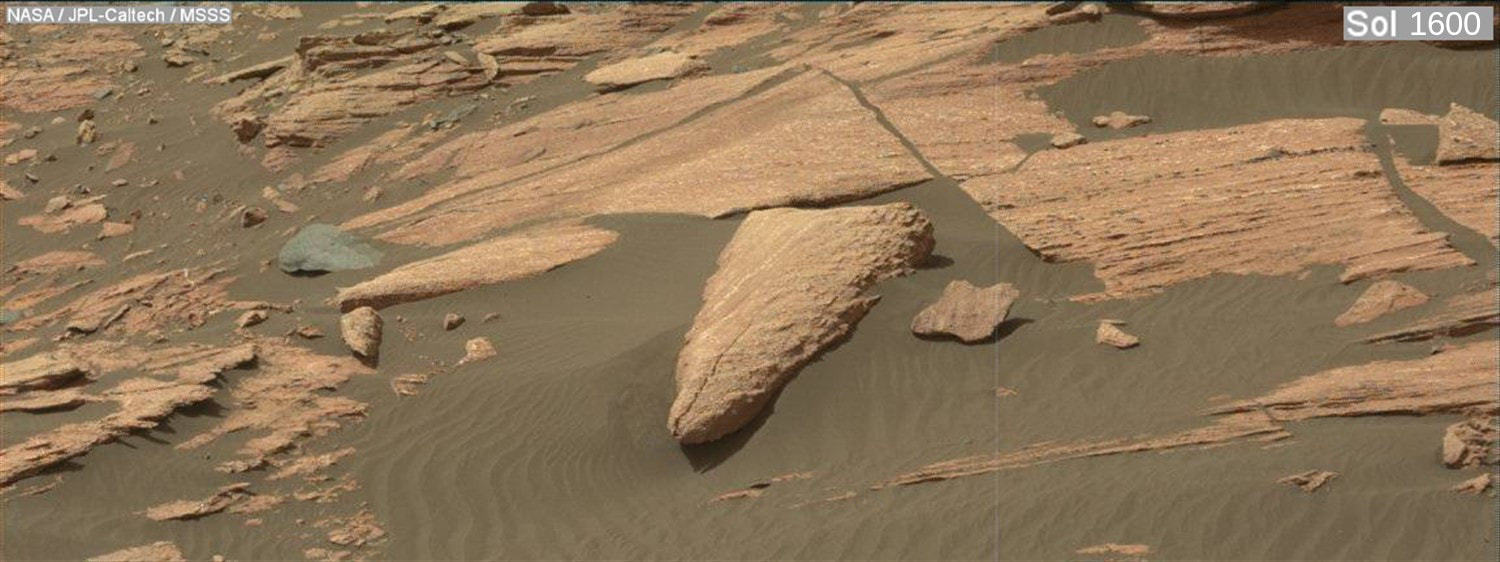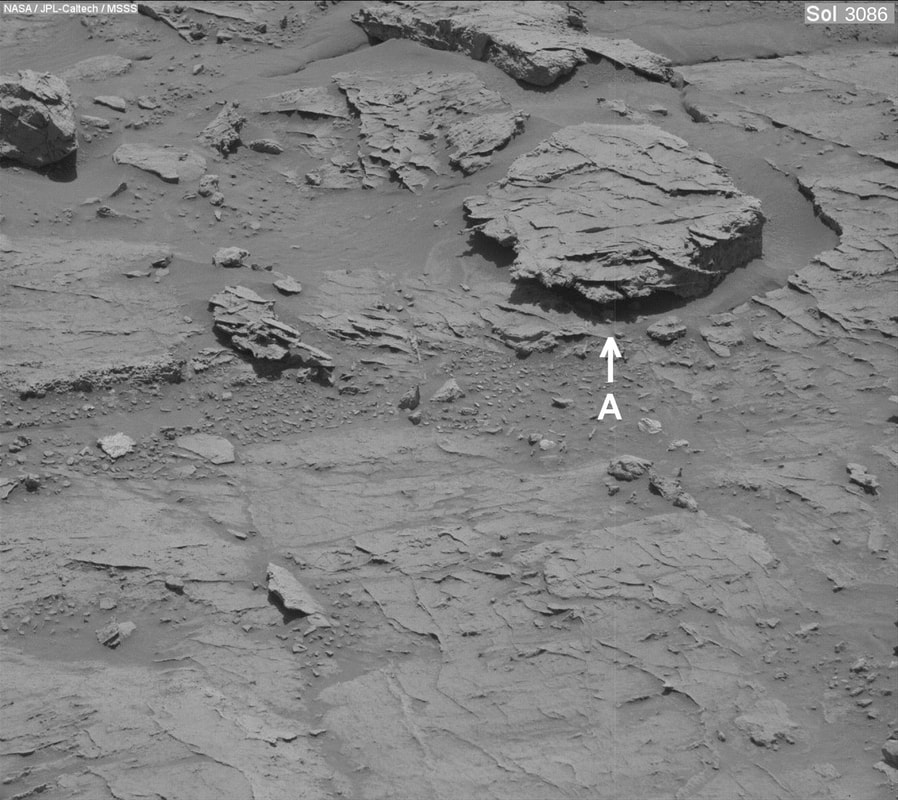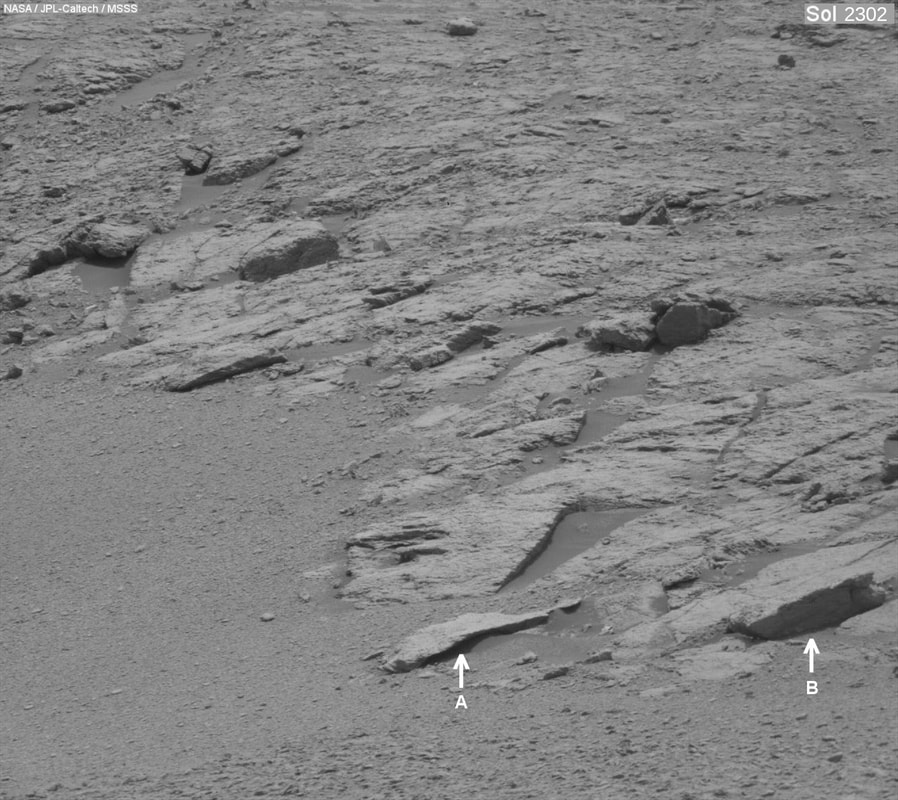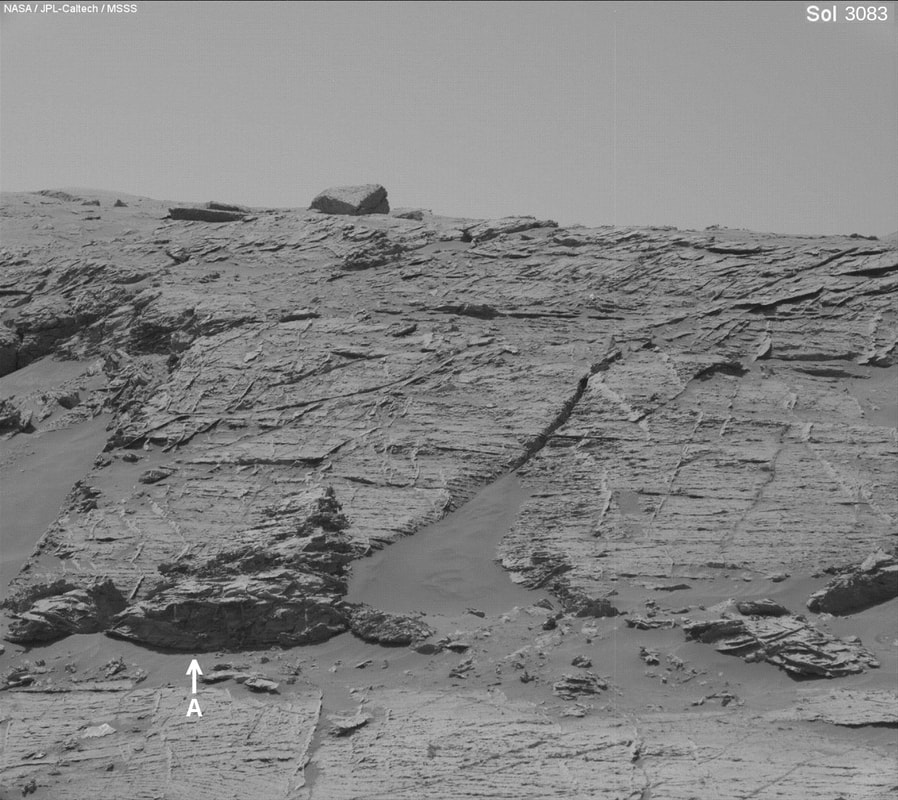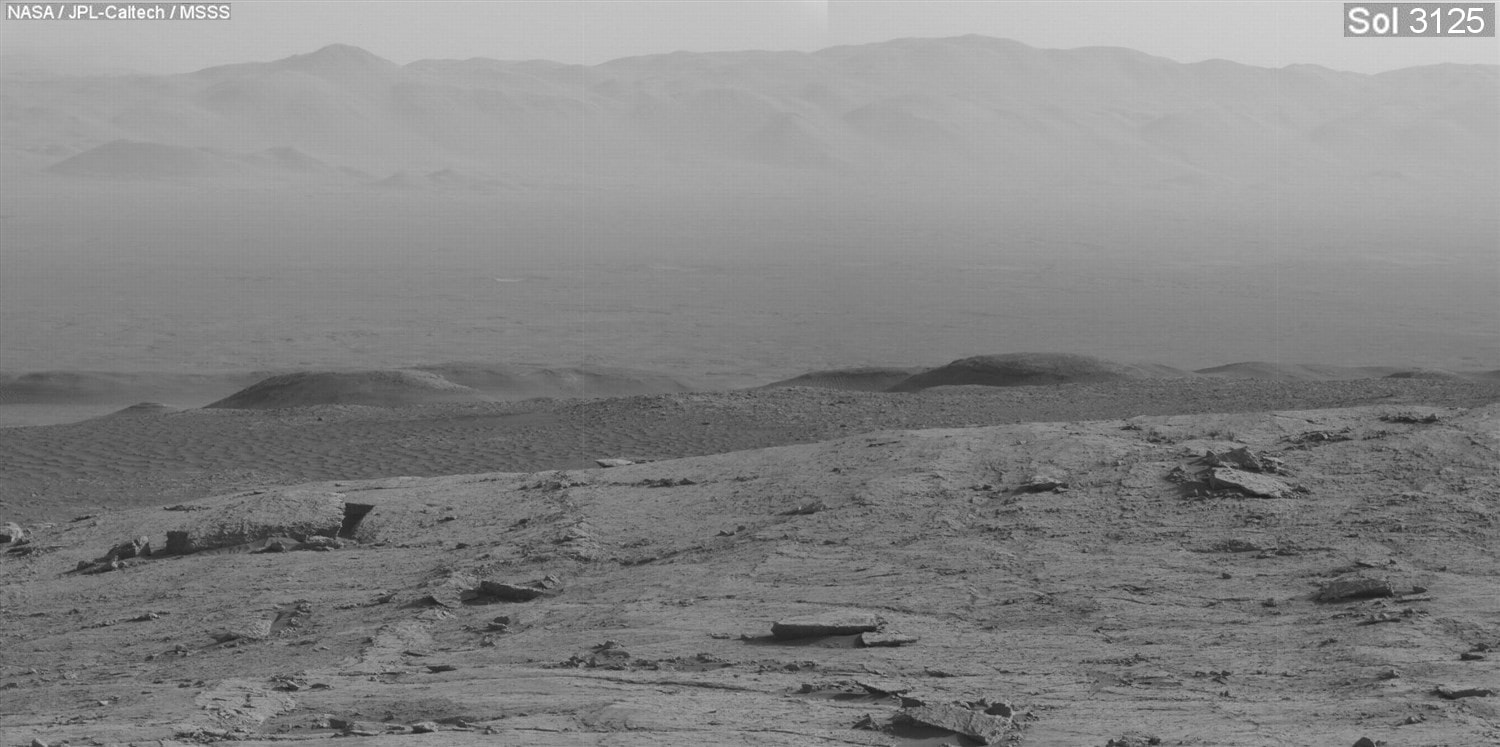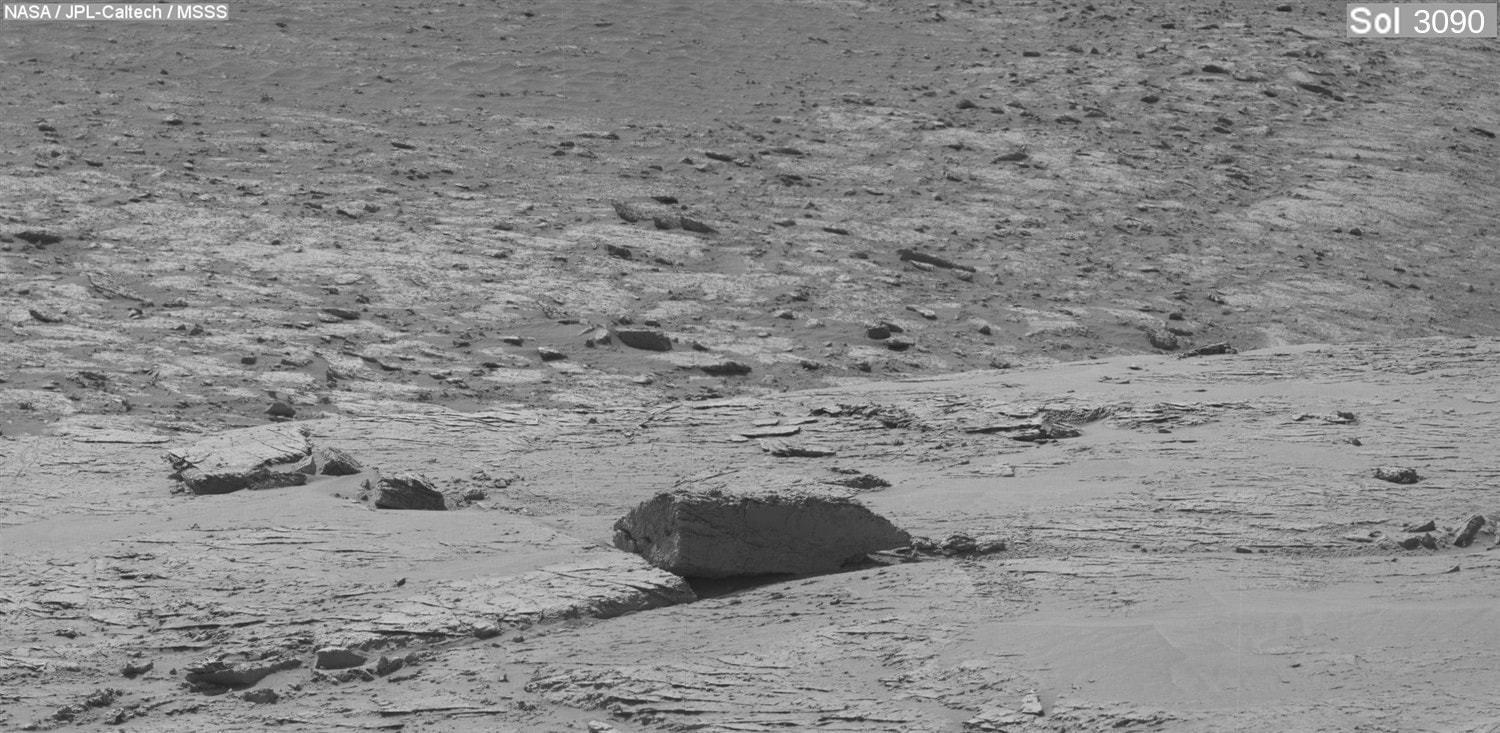| Heart of Avalonia |
Martian Analogue - Section 1
Note: All Mars photos in this section are credit NASA/JPL-Caltech/MSSS. The photos are from the mast cameras on the Curiosity rover (Mars Science Laboratory) taken during the interval Aug.6, 2012 - May 31, 2021. Some photos have been stitched from 2 or more photos retrieved from the NASA online archive of raw images.
Gale crater: Features resembling subglacial bedrock frost heave
Frost-heaved joint blocks are abundant on the Avalon Peninsula of Newfoundland. A frost-heaved joint block can be recognized unambiguously when it protrudes above adjacent bedrock and is underlain by a cavity roughly matching the cross-section of the protruding block. All of the bedrock frost heave that has occurred on the Avalon Peninsula is of subglacial origin. Key evidence pointing to subglacial bedrock frost heave is found when frost-heaved blocks have been shifted laterally in response to creep in overlying glacial ice. Without invoking the presence of glacial ice, lateral shifting of frost-heaved joint blocks would not be expected. Many other indicators can point to subglacial bedrock frost heave, but lateral shifting of blocks is one of the most convincing indicators.
The same logic can be applied when searching for evidence of subglacial bedrock frost heave on Mars. Photos of the ground can be searched for blocks that have been shifted normal to the plane of adjacent bedrock and then translated laterally. The sedimentary rocks at Gale crater show well defined, usually horizontal, bedding planes in many instances. Bedding planes appear to be a principal plane of weakness, hence plane of failure, at several of the locations photographed by Curiosity. Joints at steep angles to bedding are abundant in some of the rocks observed, but foliation is not evident. One of the consequences of the geometry of the planes of weakness in the Martian rocks (domination by horizontal bedding planes) is that most blocks detached from bedrock are low in height compared to their width.
On the Avalon Peninsula, foliation induced by regional metamorphism provides important, if not dominant, planes of weakness at most locations. Bedding planes also provide key failure planes. Bedding can be tilted from the horizontal by a few tens of degrees on the folded rock structures that underlie most of the areas where frost-heaved bedrock is found. Planes of foliation generally dip vertically. Cross jointing at steep angles to foliation is common and well-defined joint blocks are abundant. Because of the geometry of the planes of weakness in the Avalon rocks, frost heaved joint blocks are frequently taller than they are wide. This taller, thinner aspect ratio stands in contrast to the rocks at Gale crater.
The same logic can be applied when searching for evidence of subglacial bedrock frost heave on Mars. Photos of the ground can be searched for blocks that have been shifted normal to the plane of adjacent bedrock and then translated laterally. The sedimentary rocks at Gale crater show well defined, usually horizontal, bedding planes in many instances. Bedding planes appear to be a principal plane of weakness, hence plane of failure, at several of the locations photographed by Curiosity. Joints at steep angles to bedding are abundant in some of the rocks observed, but foliation is not evident. One of the consequences of the geometry of the planes of weakness in the Martian rocks (domination by horizontal bedding planes) is that most blocks detached from bedrock are low in height compared to their width.
On the Avalon Peninsula, foliation induced by regional metamorphism provides important, if not dominant, planes of weakness at most locations. Bedding planes also provide key failure planes. Bedding can be tilted from the horizontal by a few tens of degrees on the folded rock structures that underlie most of the areas where frost-heaved bedrock is found. Planes of foliation generally dip vertically. Cross jointing at steep angles to foliation is common and well-defined joint blocks are abundant. Because of the geometry of the planes of weakness in the Avalon rocks, frost heaved joint blocks are frequently taller than they are wide. This taller, thinner aspect ratio stands in contrast to the rocks at Gale crater.
The above photos show a block that has been displaced vertically from bedrock by subglacial frost heave and then translated laterally by deformational flow (creep) in an overlying cold glacier. The block, marked "A" in the first photo, was displaced from the cavity marked "B". The wedge-shaped front of the block, as seen in the center foreground of the second photo, fits into the cavity at the point where the blue case of the tape measure (reading 70 cm) sits. The back of the block originated from the point where the tape measure ends. A portion of the side of the block is missing. The missing rock has either been fragmented and fallen back into the cavity or else has been transported away by moving glacial ice.
The arrow labeled "A" in the above photo points at a block that was displaced vertically from bedrock by subglacial frost heave and then shifted laterally by glacial ice deforming in creep near the ground. The block might have risen substantially above ground level during the frost heave event, propelled upward by ice continuously forming beneath it. The higher the block rose, the more vulnerable it would be to lateral displacement by ice creep resulting from basal shear stress in the overlying glacier. The entire process occurred under cold-based glacial conditions. The dimensions and angles of the displaced block were measured and correlated with measurements from the cavity (B) to definitively confirm that the block originated from the cavity.
The block seen in the above photo from Gale crater appears to have been shifted vertically, then translated horizontally, in a process potentially matching that illustrated in the preceding photos. In most of the photos from Gale crater, wind-blown sand has filled in the cavities left behind after blocks were shifted. The presence of the sand is sometimes an advantage in allowing the horizontal dimensions of a cavity to be assessed. Unfortunately, however, the vertical dimension is obscured.
The small slab seen in the top center of the above frame has been lifted and displaced a short distance. The smaller slab underneath the left end of the main slab is probably a piece that detached from the bottom of the main slab. The thickness of the main slab is difficult to discern definitively from the photo, but it appears thin. The main slap could have been pushed upward by subglacial frost wedging and then translated horizontally by creep deformation in overlying cold glacial ice. Alternatively, the upward displacement of the slab might be an example of exfoliation that occurred as ice pressure diminished during deglaciation. The horizontal translation of the slab is hard to explain in the absence of glacial ice.
Normally, the velocity of cold glacial ice experiencing basal shear stress increases with height above ground and diminishes to zero at ground level. However, this principle does not apply when the substrate fails under shear loading.
Normally, the velocity of cold glacial ice experiencing basal shear stress increases with height above ground and diminishes to zero at ground level. However, this principle does not apply when the substrate fails under shear loading.
Two blocks, indicated "A" and "B" in the above photo have been displaced from bedrock and shifted in a similar manner. The outlines of the cavities left behind when the blocks were shifted are made visible by the more uniform sand or silt contrasting with the adjacent bedrock. The matching shifts imply consistent creep in overlying ice at both positions. Observations from the Avalon show that near-ground ice creep is often not consistent, with substantial variations occurring over short distances.
In the above photo, "A" marks a small rock fragment while "B" marks the cavity left behind when fragment "A" was displaced from bedrock. Abundant large-scale occurrences of subglacial bedrock frost heave found in the immediate area suggest that the occurrence shown above is also an example of subglacial bedrock frost heave.
The small fragment marked "A" above looks like it could have been displaced from the adjacent cavity in a manner similar to the occurrence shown in the preceding photo.
The above photo shows blocks shifted laterally from the bedrock edge seen just to the right of the hammer. It is unlikely that sliding warm-based glacial ice would have moved the blocks at this location because subglacial bedrock frost heave (a process requiring cold-based glaciation) is abundant in nearby bedrock. Basal shear stress and accompanying creep in a cold glacier could move the blocks if the strength of the bond between the blocks and underlying bedrock was weaker than the bond between glacial ice and the tops of the blocks. Alternatively, the blocks could have been pushed upward into overlying ice by the freezing of pressurized groundwater moving upward through a joint lying to the right of the hammer and now forming the failure plane there. After being pushed upward, the blocks would readily be translated horizontally by creep in overlying cold ice.
A second example of laterally-displaced blocks is shown in the above photo. A combination of upward displacement by subglacial frost heave followed by horizontal displacement by glacial ice creep could account for the observed positions of the displaced blocks.
Four separated blocks appear to have been torn away from adjacent bedrock in the above photo from Gale crater. The process might have occurred through the same combination of frost heave and subsequent lateral displacement by ice creep that was inferred to have taken place in the preceding two photos.
The large block marked "A" in the above photo was displaced from the cavity visible just above the hammer by subglacial bedrock frost heave. The block has tipped 90 degrees, with the original top surface now pointing toward the bottom of the frame. The cross-section of the block makes a definitive fit with the remnant cavity. Glacial ice creep caused the block to translate to the right. The tall, thin aspect ratio of the block is typical of bedrock frost-heave occurrences on the Avalon, but this aspect ratio is less likely to be seen in rocks at Gale crater.
The displaced block marked "A" above has an aspect ratio that is more typical of the displaced blocks seen at Gale crater. This block could be interpreted as an occurrence of subglacial bedrock frost heave, or it could be interpreted an example of exfoliation (spalling from substrate as the weight of overlying ice was removed). Bedrock in the immediate area has been heavily brecciated by a combination of subglacial frost heave and basal shear stress.
The low, but wide, aspect ratio seen in the displaced block marked "A" above is typical of the surmised frost-heave occurrences at Gale crater. The block appears to match the shape of the edge of the cavity seen to the right. The block has been pushed up over bedrock on its front and left sides. Subaerial frost heave or exfoliation (detachment of a block from substrate after removal of overburden) are both unlikely to have translated the block laterally. However, basal shear stress and associated creep in overlying glacial ice could potentially account for the displacement of the block with or without the simultaneous occurrence of frost heave.
The block marked "A" above appears to have been both lifted and translated relative to underlying bedrock. The block immediately to the right of "A" appears to have been lifted slightly but not translated. Since ice creep velocity increases from zero with increasing height above the bedrock surface, it is reasonable to expect the higher block to be preferentially translated. The possibility that the blocks were lifted via exfoliation is diminished by the observation of a second small block lying on top of "A". The stacking of blocks is more likely to reflect glacial transport. The indicated direction of lateral transport in the above-illustrated block matches that of the nearby block shown in the preceding photo.
The above photo shows a row of joint blocks that have been displaced upward by subglacial bedrock frost heave. Rows of displaced blocks are common on the Avalon and are reflective of pressurized groundwater intruding and freezing along a joint. The last two blocks in the row have been further displaced by glacial ice loading/movement. The block marked "A" has undergone the greatest displacement. This block might have been carried upward by ice accumulating from below and thus been exposed to higher lateral ice velocity.
The block at the upper right in the above photo suggests bedrock frost heave action and subsequent lateral transport by glacial ice. The block appears to have cleaved off along a joint that can be seen extending (perhaps as a small fissure) downward and to the right. Frost heave appears to have continued along the same joint upward and to the left, but without lateral translation of the raised blocks.
Another view of the block shown in the preceding photo appears in the above picture. Note the apparent void at the bottom right of the displaced block. This implies that the block is most likely a displaced block rather than the result of an erosion process etching out blocks from unmoved bedrock. A similar criterion is applied to Avalon rocks to help separate probable instances of frost-heaved bedrock from other artifacts of glacial erosion.
"A" and "B" in the above photo indicate possible occurrences of glacially displaced fingers of bedrock. Occurrence "A" shows evidence of having been raised above the level of adjacent bedrock by frost heave action.
The block appearing in the sand at the center of the above photo was probably transported from the appropriately shaped slot seen in the background. This transport is suggestive of glacial activity. Bedrock frost heave is not conclusively demonstrated in the photo. However, frost wedging could have caused release of the block from bedrock, and ice accumulating beneath and behind the block could have moved the block into a zone of increased glacial ice deformational velocity.
The above photo shows a bedrock terrace where a combination of frost heave and glacial transport appears to have carved out notches and moved resultant rock fragments downhill. Block "A" may have separated from the notch seen in the preceding level on the terrace. If that happened, then the notch on the bottom tier was carved without leaving any rock fragments visible in the photo. The short fissure "B" could be the result of ice having wedged apart adjacent blocks of bedrock. Alternatively, "B" could be a remnant cavity where a small section of rock was ejected and carried away by glacial ice. Notch "C" has rock fragments scattered in front of it. On the Avalon, it is common for subglacial ice intrusion to fragment bedrock and transport the fragments a short distance.
The above photo shows a notch in a bedrock outcrop with the associated displaced fragment located nearby. The geometry suggests that the fragment was lifted up into moving glacial ice, or else that the fragment was forced to move horizontally by ice accumulating behind it. In either case, basal shear stress imparted by overlying glacial ice forced the motion of ice and rock rightward as seen on the photo.
The blocks marked "A" in the above photo were displaced upward by the freezing of intruding groundwater, then displaced laterally by glacial ice loading/movement. Debris (brecciated bedrock) in the underlying cavity prevented the frost-heaved blocks from falling back into the cavity after glacial ice departed. Two other blocks (marked "B") were transported further by glacial ice deforming in creep. Presumably, these blocks were pushed higher into the glacier by underlying accumulating ice. They then experienced higher glacial ice velocity.
The block marked "A" in the above photo has been lifted above the height of adjacent bedrock in a manner that could indicate bedrock frost heave. The block has been shifted to the left as indicated by the sand-filled cavity seen just to the right.
Both blocks "A" and "B" above show evidence of substantial vertical displacement, an indicator of possible bedrock frost heave. Additionally, both blocks appear to have been shifted laterally. A partial outline of a sand-filled cavity can be seen immediately to the right of block "A". A potential source cavity for block "B" can be seen just above and to the left of the block.
With the side-wall of the adjacent cavity closely matching the shape of block "A" above, there can be little doubt that this block has been translated to the right. This rightward shift indicates possible glaciotectonic loading that might or might not have been preceded by bedrock frost heave.
The right-angled fissure seen above clearly implies shifting of the adjacent block to the right. The shifted block appears to have slid up over underlying bedrock on its right-hand side.
Block "A" above is a possible example of frost-heaved bedrock that has been laterally shifted by glacial action. A plausible source cavity for the block can be seen just to the left of the block.
Three possible instances of bedrock frost heave and/or glacial action can be seen in the above photo. Block "A" most clearly shows evidence of displacement normal to the ground and subsequent rightward translation of the block. Instances "B" and "C" are less distinct, but show similar indications of cavities formed when rock was shifted to the right.
Block "A" seen in the above photo is one of a row of blocks that has been displaced upward in a subglacial frost heave event and then pushed out over adjacent bedrock by glaciotectonic action. A fissure was formed behind the row of blocks as they were displaced.
The above photo appears to show a number of blocks that detached from bedrock and were shifted downhill. It is possible that bedrock frost heave dislodged some of these blocks. The blocks might then have been transported downhill by cold glacial ice deforming in creep as the ice moved toward lower elevation.
The joint block labelled "A" above was moved from a position alongside "B" by glacial ice deforming in creep. It is probable that block "A" was pushed upward into moving ice by subglacial bedrock frost heave. Block "B" was also shifted, but was not lifted sufficiently to experience substantial lateral ice loading.
The block marked "A" above appears to have originated from a cavity to the lower right of the block. The block has subsequently rotated about a horizontal axis, top toward the upper left. Bedrock frost heave in conjunction with glacial ice deforming with above-ground velocity directed toward the upper left could account for the observed shift in the position and orientation of the block.
Block "A" above is a frost-heaved joint block that was subsequently translated horizontally by glacial ice. Since the velocity of deforming cold glacial ice increases with increasing height above ground, it would be reasonable to assume that block "A" would tip forward (toward upper right in frame) as it was being shifted. The present vertical orientation of the block could have resulted from it tipping backward after glacial ice departed. Alternatively, ice extruded from the section of bedrock seen below the hammer might have roughly matched glacial ice creep in contributing to the horizontal displacement of block "A". Block "A" now rests on a bed of brecciated bedrock.
The bedrock shown in the above photo appears to have been fragmented by a process that could have included bedrock frost heave and/or brecciation by deforming glacial ice. Block "A" has been detached from nearby bedrock, displaced vertically, displaced horizontally and rotated. Block "B" has been displaced vertically. The other blocks cannot readily be correlated. Disordered brecciation of bedrock by subglacial frost heave is commonly observed at several locations on the Avalon. One possible cause is the continuous intrusion of ice beneath a top layer of bedrock. The layer becomes fragmented and the fragments are separated from bedrock and pushed upward into the overlying glacier. When glacial ice eventually melts and departs, the fragments can settle back to the ground in a chaotic pattern.
Ice extruded from the ground has brecciated bedrock to produce the irregular cavity "B" shown above. Block "A" was ejected from the cavity into overlying glacial ice, eventually settling back at an irregular orientation.
Deforming cold glacial ice aided by ice intruding from below has brecciated sedimentary bedrock in the scene shown above. The hammer rests on a failure surface following sedimentary bedding. The blocks to the right of the hammer have not yielded to frost heave. Frost-heaved blocks that remain anchored in the bedrock on the left side of the outcrop have corralled multiple loose blocks that originated on the right side of the outcrop. These loose blocks were not lifted sufficiently to cause them to settle in an irregular pattern. However, many other blocks from the same group are missing from the scene entirely. These missing blocks were lifted sufficiently to be carried away by glacial ice that moves faster with increasing distance above the ground.
A subglacial process similar to that described for the preceding photo could account for the brecciation and subsequent scattering of small blocks seen in the above photo.
The two photos above show the same area, with the second photo showing a closeup of the background portion of the first photo. The bedrock landscape has been brecciated, separating a top layer of rock into multiple shifted fragments. The three marked blocks, "A", "B", and "C" have all been shifted to the right. The similar shifts of these three blocks, if caused by glacial ice, would suggest a degree of uniformity of basal ice stress over the whole area.
The above photo shows a row of frost-heaved joint blocks. The blocks "A" at the end of the row have been ejected from substrate and then transported laterally by cold glacial ice deforming in creep.
A section of raised bedrock, demonstrating frost-heave in a subglacial environment, is shown above. Glacial ice movement has detached and deflected two blocks on the top right of the feature. Presumably, other block(s) just to the right of the deflected blocks have been removed from the scene by glacial ice transport.
In the above photo, block "A" appears to have been lifted and transported laterally to the left, detaching "A" from "B". The irregular break between the two sections of rock indicates loading in excess of the strength of the rock. The breakage appears unaided by the presence of a pre-existing joint or plane of weakness. The dividing of the rock could have been caused by glacial ice loading, frost heave, or a combination of the two.
Block "A" in the above photo appears to have been shifted upward, potentially by subglacial bedrock frost heave, and then transported down slope, a possible consequence of glacial ice movement. The block appears poorly lithified, but could have been much stronger if saturated with water and frozen.
The triangular-shaped block in the foreground above appears to have been detached from bedrock above and to the right in the frame, then translated toward the left and rotated. Glacial ice loading could account for this motion. Note the grey-colored rock in the center-left of the frame. This rock differs in appearance from local bedrock and could be a glacially-transported erratic.
Block "A", seen in the above photo, represents a potential occurrence of subglacial bedrock frost heave. The block has been elevated relative to host bedrock and the left side of the block now rests on intact bedrock.
A triangular-shaped cavity can be seen above and to the right of the block marked "A" in the above photo. The apparent shape of block "A" does not match the shape of the cavity precisely. Nevertheless, it is plausible that block "A" originated from the cavity in a frost heave event followed by glacial transport. Block "B" appears to be a frost-heaved block that has not been shifted laterally. Other evidence of possible frost heave and glacial transport can be seen in the upper left area of the image.
Block "A", seen in the above photo, is a possible candidate for having been displaced from the adjacent cavity by subglacial frost heave and subsequent glacial transport.
In the above photo, block "A" shows evidence of possible frost heave followed by lateral displacement to the left under glacial ice loading. Block "B" is a potential frost-heaved block that may have originated in a cavity seen just in front of the block and extending slightly to the left.
The block seen in the center foreground of the above image is a detached block with its elevated front corner resting on adjacent bedrock. Frost heave or glacial action could have shifted this block to its present position. Since no nearby cavity is apparent, the block was either lifted from bedrock directly beneath itself, or else the block was transported a substantial distance from a location not visible in the frame.
Return to page Mars or view Martian Analogue - Section 2 (Bedrock Brecciation at Gale Crater)
heartofavalonia.org Exploring Geologic History
